| (19) |
 |
|
(11) |
EP 0 343 717 B1 |
| (12) |
EUROPEAN PATENT SPECIFICATION |
| (45) |
Mention of the grant of the patent: |
|
27.07.1994 Bulletin 1994/30 |
| (22) |
Date of filing: 17.05.1989 |
|
|
| (54) |
UV stabilizers for organic polymers
UV-Stabilisatoren für organische Polymere
Stabilisants UV pour des polymères organiques
|
| (84) |
Designated Contracting States: |
|
AT BE CH DE ES FR GB GR LI LU NL SE |
| (30) |
Priority: |
27.05.1988 IT 2076288
|
| (43) |
Date of publication of application: |
|
29.11.1989 Bulletin 1989/48 |
| (73) |
Proprietor: GREAT LAKES CHEMICAL ITALIA S.r.l. |
|
I-20138 Milano (IT) |
|
| (72) |
Inventors: |
|
- Costanzi, Silvestro
I-20098 San Guiliano
Milanese Milan (IT)
- Cassar, Luigi
I-20097 San Donato
Milanese Milan (IT)
- Busetto, Carlo
I-20097 San Donato
Milanese Milan (IT)
- Neri, Carlo
I-20097 San Donato
Milanese Milan (IT)
- Gussoni, Damiano
I-20133 Milan (IT)
|
| (74) |
Representative: Fusina, Gerolamo et al |
|
Ing. Barzanò & Zanardo Milano S.p.A,
Via Borgonuovo, 10
20121 Milano
20121 Milano (IT) |
| (56) |
References cited: :
EP-A- 0 162 524
DE-A- 1 570 759
US-A- 4 177 186
|
EP-A- 0 263 561
US-A- 3 355 425
|
|
| |
|
|
- CHEMICAL ABSTRACTS, vol. 111, no. 26, 25 December 1989, page 53, abstract no. 234372k,
Columbus, Ohio, US ; & JP-A-o196259
|
|
| |
|
|
|
Remarks: |
|
The file contains technical information submitted after the application was filed
and not included in this specification |
|
| Note: Within nine months from the publication of the mention of the grant of the European
patent, any person may give notice to the European Patent Office of opposition to
the European patent
granted. Notice of opposition shall be filed in a written reasoned statement. It shall
not be deemed to
have been filed until the opposition fee has been paid. (Art. 99(1) European Patent
Convention).
|
[0001] This invention relates to stabilizer compounds containing sterically hindered piperidino
groups in the molecule and suitable for stabilizing organic polymers against ultraviolet
radiation and heat.
[0002] The invention also relates to methods for preparing said stabilizer compounds and
to the stabilized polymer compositions.
[0003] Organic polymers are known to be subject to degradation with time on exposure to
atmospheric agents and in particular to ultraviolet radiation, and to also suffer
degradation during working and transformation processes due to the high temperatures
reached.
[0004] Such degradation manifests itself as a worsening of the organic polymer physical
characteristics, such as a reduction in the ultimate tensile stress and flexibility,
and alterations in the optical properties of a manufactured article.
[0005] It is usual to introduce stabilizer compounds into the organic polymer to oppose
such degradation.
[0006] One class of compounds widely used for this purpose is the sterically hindered amine
class. US-A-4325864 and US-A-4346188 describe for example the use of pyrrolidine derivatives
as UV stabilizers, and US-A-3840494 describes the use of esters of 2,2,6,6-tetraalkylpiperidin-4-ol.
EP-A-0162524 and EP-A-0263561 describe pyrrolidine, morpholine and piperidine derivatives
also introducing a hydrolysable silylated function to the molecule.
[0007] On hydrolysing the silylated function, these compounds give rise to complex resin
structures able to permanently remain within the organic polymer in which they are
incorporated.
[0008] However, such resinification is not easily controllable especially when effected
within polymers to be stabilized.
[0009] A class of stabilizer compounds of polymer type containing sterically hindered piperidino
groups has been discovered which can be easily prepared in the form of well defined
predetermined structures.
[0010] US-A-4,177,186, for example, discloses a stabilizer compound which is a poly(diorganosiloxane)
having terminal 2,2,6,6-tetramethyl piperydil groups.
[0011] Such stabilizer compound is useful for stabilizing a number of polymers against light-induced
deterioration. It presents, however, low hydrolytic stability due to the poor stability
to hydrolysis of the Si-O bond.
[0012] The present invention relates to polymeric stabilizer compounds containing sterically
hindered piperidino groups, enabling the afore said drawbacks to be obviated.
[0013] The invention also relates to methods for preparing said stabilizer compounds.
[0014] The invention further relates to polymer compositions stabilized by said polymeric
stabilizer compounds.
[0016] The stabilizers of the present invention, corresponding to said formula (I), are
polymers having random distribution of the monomer units and a linear or cyclic structure.
[0017] In particular, they assume a linear structure when A and B are groups corresponding
to formulas (III) and (IV), whereas they assume a cyclic structure when A and B jointly
represent a direct bond.
[0018] In the case of a linear structure, stabilizers are preferred in which the total number
of monomer units (

) ranges from 10 to 50, while in the case of a cyclic structure stabilizers are preferred
in which m and p are zero and n varies from 4 to 7.
[0019] In particular, in the case of stabilizers with a linear structure, a more preferred
class is that in which:
R₁ is CH₃;
R₂ is the group corresponding to the formula:

p is zero;
m and n vary from 5 to 15.
[0020] A second more preferred class is that in which:
R₁ and R₃ are CH₃;
R₂ is the group of formula (V);
p and m are zero;
n varies from 30 to 40.
[0021] A third more preferred class is that in which:
R₁ is CH₃;
R₂ is the group of formula (V);
R₃ is -CH₂-(CH₃)₇;
p is zero;
m and n vary from 15 to 20.
[0022] A fourth more preferred class is that in which:
R₁ is CH₃;
R₂ is the group of formula (V);
m is zero;
p varies from 5 to 12;
n varies from 25 to 30.
[0023] A fifth more preferred class is that in which:
R₁ and R₃ are CH₃;
R₂ is the group corresponding to the formula:

p is zero;
n varies from 20 to 25 - m varies from 8 to 10;
In the case of stabilizers of cyclic structure, a more preferred class is that
in which:
R₁ is CH₃;
R₂ is the group of formula (V);
p and m are zero;
n varies from 4 to 7.
[0024] The polymeric stabilizer compounds of the present invention in which R₂ corresponds
to formula (II) where q is one, can be prepared by bringing a polyorganosiloxane compound
corresponding to the formula:

where A, B, R₁, R₃, n, p and m have the aforesaid meanings, into contact under reaction
conditions with an unsaturated piperidino compound corresponding to the formula:

in which R₄, R₅, R₆ and z have the aforesaid meanings,
until between 1 and n+p Si-H groups present in (VI) have undergone reaction.
[0025] The Si-H groups of the polyorganosiloxane compound (VI) constitute the reactive sites
to which the unsaturated piperidino compound (VII) binds.
[0026] All the said Si-H groups can be made to react, to give rise to stabilizer compounds
in which p is zero in formula (I), or alternatively only some of them may be reacted
to give rise to stabilizer compounds in which free Si-H groups are still present (p
is a whole number in formula I).
[0027] Consequently, according to the present invention the reaction is conducted until
between 1 and n+p Si-H groups have been reacted, the reaction generally being brought
to completion by using a piperidino compound quantity of up to 25% molar excess over
the amount of substitution to be obtained.
[0028] The reaction is conducted at a temperature of between 0 and 140°C and preferably
between 80 and 120°C for a time period of between 1 and 10 hours, using as catalyst
a complex of a noble metal chosen from Pt and Rh, for example hexachloroplatinic acid
(H₂PtCl₆) or rhodiumchloridetriphenylphosphine [RhCl(PPh₃)₃].
[0029] The catalyst concentration, evaluated as metal concentration, can vary from 1 to
200 parts per million (ppm) in the reaction medium and preferably between 5 and 50
ppm.
[0030] The reaction can be conveniently conducted in the absence of solvent or in the presence
of an inert organic solvent chosen from aliphatic, cycloaliphatic or aromatic hydrocarbons,
such as heptane, cyclohexane or toluene. On termination of the reaction, any solvent
and the excess reagent are removed by evaporation under vacuum, and the stabilizer
compound is obtained as residue.
[0031] The unsaturated piperidino compounds corresponding to formula (VII) can be prepared
by known methods such as described in the EP-A-0244027 whereas the polyorganosiloxane
compounds (VI) are readily available commercially.
[0032] Those stabilizer compounds of the present invention in which R₂ is represented by
formula (II) where q is zero can be obtained by bringing a polyorganosiloxane compound
corresponding to the aforesaid formula (VI) into contact under reaction conditions
with a piperidino compound corresponding to the following formula:

where z and R₄ have the aforesaid meanings,
until between 1 and n+p Si-H groups present in compound (VI) have undergone reaction.
[0033] According to the present invention the reaction is conducted at a temperature of
between 20 and 150°C and preferably between 60 and 120°C for a reaction time of between
1 and 10 hours.
[0034] The reaction is continued until between 1 and n+p Si-H groups present in the polyorganosiloxane
compound (VI) have been reacted, the reaction generally being brought to completion
by using a piperidino compound quantity of up to 10% molar excess over the amount
of substitution to be obtained.
[0035] The catalysts used are metallic alcoholates, preferably of alkali metals such as
CH₃ONa, or are metal salts of fatty acids such as dibutyltin dilaurate or Zn octoate.
[0036] The catalyst quantity used ranges from 0.01 to 5 mol% of the piperidino compound
(VIII) and preferably from 0.1 to 1 mol%.
[0037] The reaction is conducted in the presence of an inert organic solvent chosen from
aliphatic, cycloaliphatic and aromatic hydrocarbons such as heptane, cyclohexane and
toluene.
[0038] According to a further embodiment of the present invention the polymeric stabilizer
compounds of the invention in which R₂ is represented by formula (II) where z is -O-
and q is one can be prepared by a method comprising the following stages conducted
in succession:
a) reacting a polyorganosiloxane compound represented by the aforesaid formula (VI)
with an unsaturated compound corresponding to the following formula:

in which X = Br or Cl;
R₅ and R₆ have the aforesaid meaning,
to give a polyorganosiloxane compound corresponding to the following formula:

where R₁, R₃, R₅, R₆, A, B, X, n, p and m have the aforesaid meanings;
b) reacting compound (X) obtained in stage a) with a piperidino compound corresponding
to the formula:

where R₄ has the aforesaid meaning, and M is Na, K or Li.
[0039] In stage a) the procedure is conducted at a temperature of between 0 and 140°C and
preferably between 80 and 120°C for a time of between 1 and 10 hours, generally using
an excess of the unsaturated compound (IX) of up to 25% over the extent of substitution
to be obtained. The catalyst used is a noble metal complex, preferably of Pt or Rh,
for example hexachloroplatinic acid (H₂PtCl₆) or rhodiumchloridetriphenylphosphine
[RhCl(PPH₃)₃]. The catalyst concentration expressed as metal is between 1 and 200
parts per million (ppm) in the reaction medium and preferably between 5 and 50 ppm.
[0040] The reaction is generally conducted in the presence of an inert organic solvent chosen
from aliphatic, cycloaliphatic and aromatic hydrocarbons, such as heptane, cyclohexane
or toluene.
[0041] The solvent and the excess reagent (IX) are then removed by evaporation under vacuum,
the compound (X) being obtained as residue.
[0042] In accordance with stage b) said compound (X) is then reacted with the piperidino
compound (XI) used in stoichiometric quantity with respect to compound (IX).
[0043] The reaction is conducted in the presence of an inert organic solvent, generally
the same as that used in stage a), at a temperature of between 20 and 80°C for a time
of between 4 and 10 hours.
[0044] The final product is then recovered by adding water, extracting with an organic solvent
and evaporating the solvent.
[0045] The stabilizer compounds of the present invention can be used for stabilizing organic
polymers in general against the degradative action of ultraviolet radiation and heat.
[0046] Organic polymers particularly suitable for this purpose are olefin polymers such
as polypropylene, low and high density polyethylene, low density linear polyethylene,
polybutadiene; olefin and diolefin copolymers and terpolymers such as ethylene-propylene
copolymers, ethylene-propylene-norbonene terpolymers; copolymers of olefins with vinyl
monomers such as ethylene-vinylacetate copolymers; polystyrene; copolymers and terpolymers
of styrene with dienes or acrylic monomers such as styrene-butadiene copolymers, styrene-acrylonitrile
copolymers and acrylonitrile-butadiene-styrene terpolymers.
[0047] Said stabilizer compounds can also be advantageously used in stabilizing urethane
polymers, which can form the basis of surface coatings such as paints or lacquers.
[0048] The quantity of stabilizer compound required to obtain a stabilized polymer composition
according to the present invention is such as to provide the composition with between
0.0005 and 0.27% by weight of active nitrogen and preferably between 0.003 and 0.05%,
the active nitrogen being the nitrogen of the piperidine ring.
[0049] In practice, the quantity of stabilizer compound which can be added to the organic
polymer ranges from 0.01 to 5% by weight of the organic polymer, and preferably between
0.05 and 1%.
[0050] The stabilizer compounds of the present invention can be introduced into the polymer
to be stabilized by the normal methods used to incorporate additives.
[0051] For example, according to one embodiment of the present invention, the stabilizers
can be added to the organic polymer in the final desired quantity and these then mixed
in a mixer, such as of Bambury type.
[0052] Alternatively, the organic polymer in powder form can be mixed with a quantity of
stabilizer compound of about 10-20% by weight of the organic polymer, the stabilized
polymer compositions then being prepared by suitably diluting said mixture.
[0053] According to a further embodiment of the present invention the stabilizer compounds
can be introduced into the organic polymer as solutions or dispersions in a solvent
or dispersing agent, which is then removed after mixing.
[0054] Said stabilizer compounds can also be introduced into the polymer to be stabilized
during the preparation of this latter, generally when it is in the lattice state,
to obtain prestabilized organic polymers in this manner.
[0055] Those stabilizer compounds of the present invention which still contain free Si-H
groups can also be fixed to a solid support containing surface hydroxyl groups.
[0056] Supports suitable for this purpose are siliceous materials of natural or synthetic
origin such as silica gel, glass fibre, talc, kaolin, mica, celite or diatomaceous
earth, or other products used as fillers and pigments for plastics, such as titanium
dioxide.
[0057] Adhesion to the support is obtained in practice by bringing the support in powder
or granule form into contact with a solution of the stabilizer compound in an inert
organic solvent such as an aliphatic, cycloaliphatic or aromatic hydrocarbon, at a
temperature between ambient (20-25°C) and 100°C for a time of between 1 and 10 hours.
[0058] The thus supported stabilizer is added to the organic polymer to be stabilized using
the normal filler incorporation methods.
[0059] Those stabilizers of the present invention which contain free Si-H groups can also
be used to cover finished manufactured articles having hydroxyl groups on their surface,
such as cotton prints.
[0060] In this manner it is also possible to benefit from the intrinsic hydrophobic properties
of polyorganosiloxanes, to give the manufactured article water-repellent properties
as well as stability towards light.
[0061] If desired, the stabilized polymer compositions of the present invention can also
contain other UV stabilizers and/or one or more other additives commonly used in the
art, such as phenolic antioxidants, phosphite-based stabilizers, UV radiation absorbers
and peroxide decomposers in a quantity ranging from 0.07 to 5% by weight of the organic
polymer.
[0062] The examples given below are for illustrative purposes only and are not to be considered
limitative of the scope of the invention.
EXAMPLE 1
Preparation of compound XII:
[0063]

25 g (0.01 moles) of polymethylhydrogensiloxane of molecular weight 2500 (in formula
XI: m=0, n+p=39, A=group of formula III, B=group of formula IV, R₁=CH₃) and 0.1 ml
of a solution obtained by dissolving 1 g of H₂PtCl₆.6H₂O in 50 ml of isopropanol are
introduced into a 200 ml reaction flask.
[0064] The solution obtained is heated to 85-90°C and 100 g (0.51 moles) of 2,2,6,6-tetramethyl-4-allyloxypiperidine
are then added dropwise over a period of two hours.
[0065] After the addition, the reaction mixture is kept at 90°C for 5 hours.
[0066] The excess 2,2,6,6-tetramethyl-4-allyloxypiperidine and the volatile byproducts are
then removed by evaporation under vacuum 13.33 Pa ((0.1 mmHg)) at 180°C.
[0067] 103 g of a colourless or slightly straw coloured liquid are obtained corresponding
to the compound of formula XII. The structure was confirmed by IR and NMR spectroscopy.
Elementary analysis gave the following results:
| |
Si |
N |
C |
H |
| Theoretical (%) |
11.2 |
5.3 |
60.7 |
10.6 |
| Experimental (%) |
11.5 |
5.1 |
62 |
11 |
EXAMPLE 2
Preparation of compound XIII:
[0068]

The procedure of Example 1 is followed, using 1,2,2,6,6-pentamethyl-4-allyloxypiperidine
instead of 2,2,6,6-tetramethyl-4-allyloxypiperidine.
[0069] The polymer obtained corresponds to the compound of formula XIII. Elementary analysis
gave the following results:
| |
Si |
N |
C |
H |
| Theoretical (%) |
10.7 |
5.1 |
61.7 |
10.7 |
| Experimental (%) |
11 |
4.9 |
62.2 |
11.3 |
EXAMPLE 3
Preparation of compound XIV:
[0070]
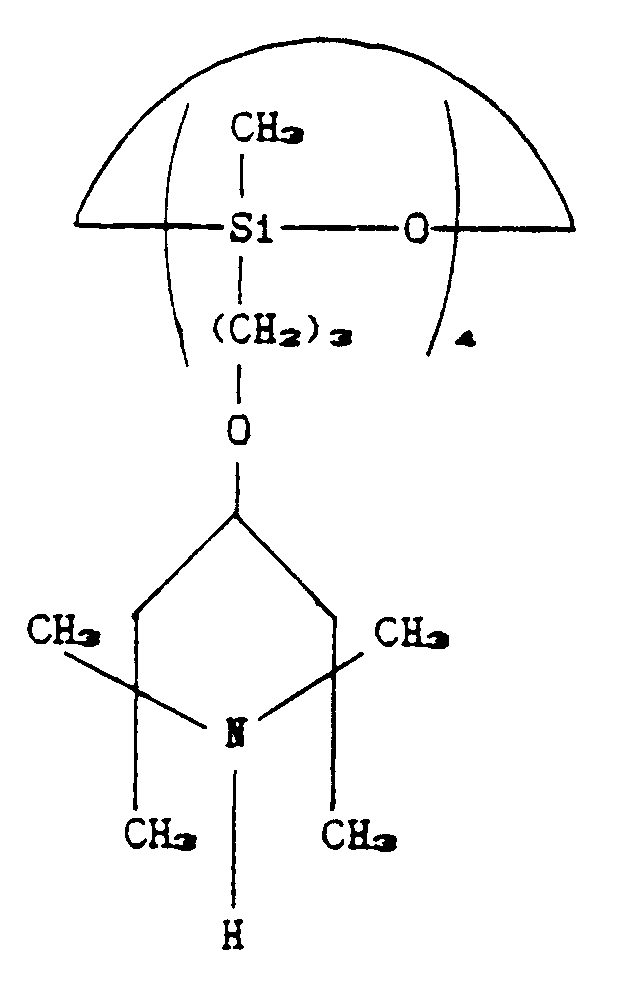
24 g (0.01 moles) of tetramethylcyclohydrogensiloxane (in formula X: m=0, n+p=4, R₁=CH₃,
A and B are a direct bond) and 0.05 ml of a solution obtained by dissolving 1 g of
H₂PtCl₆.6H₂O in 50 ml of isopropanol are introduced into a 200 ml reaction flask fitted
with a stirrer, thermometer, dropper and reflux condenser with a nitrogen head valve.
[0071] The solution obtained is heated to 90°C and 98.5 g (0.5 moles) of 2,2,6,6-tetramethyl-4-allyloxypiperidine
are then added dropwise over a period of two hours.
[0072] After the dropwise addition, the reaction mixture is kept at 90°C for 5 hours, after
which the volatile byproducts and the excess 2,2,6,6-tetramethyl-4-allyloxypiperidine
are then removed.
[0073] In this manner, 99.8 g of a colourless or slightly straw coloured viscous liquid
product not further subjectable to distillation are obtained corresponding substantially
to the compound of formula XIV. The structure was confirmed by NMR and IR spectroscopic
analysis. Elementary analysis gave the following results:
| |
Si |
N |
C |
H |
| Theoretical (%) |
10.8 |
5.4 |
60.7 |
10.5 |
| Experimental (%) |
11.2 |
5.1 |
53.7 |
11 |
EXAMPLE 4
Preparation of compound XV:
[0074]
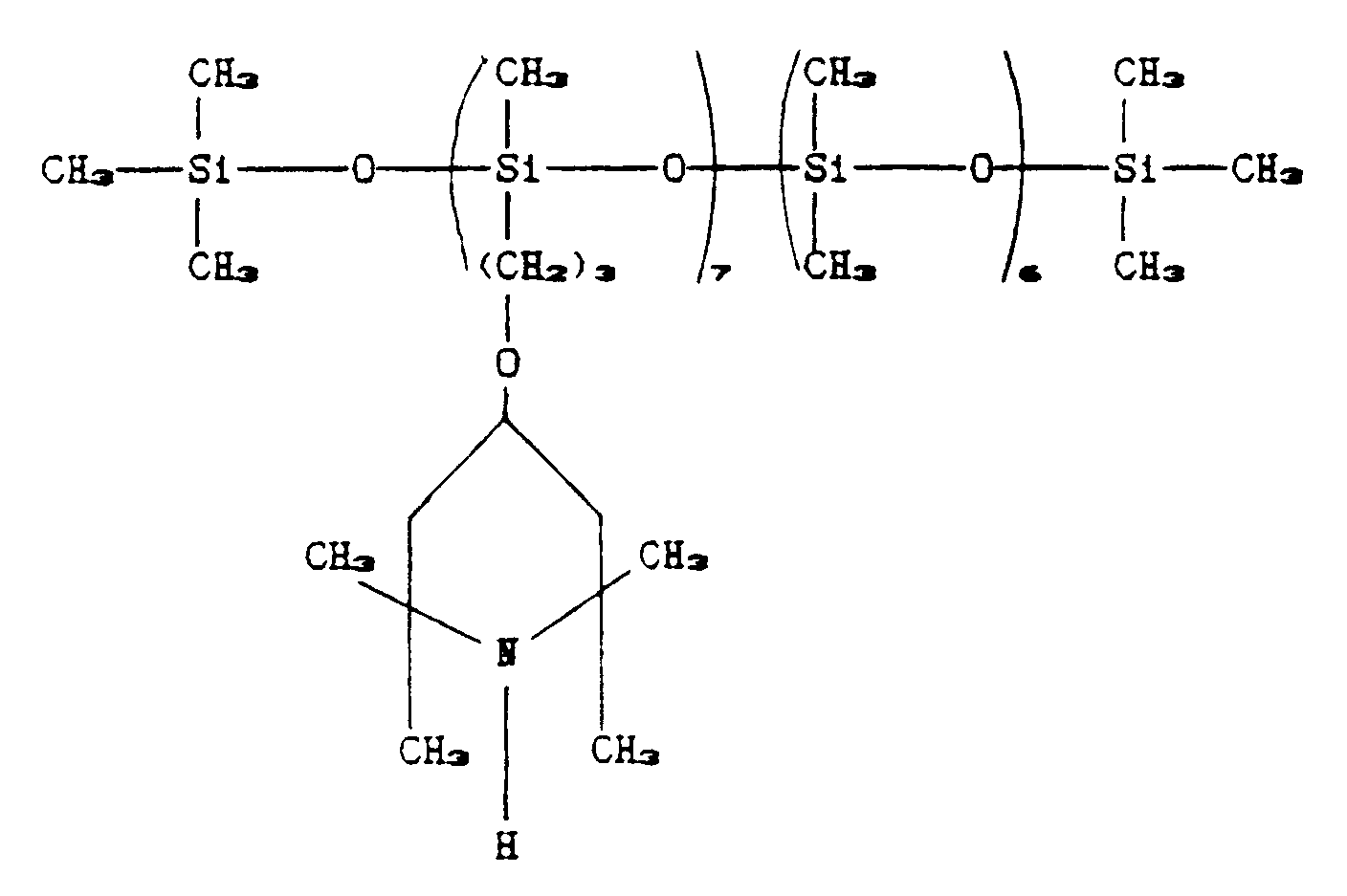
10 g (0.01 moles) of polymethylhydrogen-dimethylsiloxane copolymer or average molecular
weight 1000 containing 50% by weight of each monomer (in formula XI: R₁=CH₃, R₃=CH₃,
A is group III, B is group IV, n+p=7, m=6) and 0.05 ml of a solution obtained by dissolving
1 g of H₂PtCl₆.6H₂O in 50 ml of isopropanol are introduced into a 50 ml reaction flask
fitted with a stirrer, thermometer, dropper and reflux condenser with a nitrogen head
valve.
[0075] The mixture obtained is heated to 95°C and 19.7 g (0.1 moles) of 2,2,6,6-tetramethyl-4-allyloxypiperidine
are then added dropwise over a period of one hour.
[0076] After the addition, the reaction mixture is kept stirring for 4 hours at 95°C, after
which the excess 2,2,6,6-tetramethyl-4-allyloxypiperidine is removed under vacuum
13.33 Pa ((0.1 mmHg)) at 180°C.
[0077] In this manner, 22.9 g of a slightly straw coloured polymer residue of viscous appearance
are obtained corresponding to the compound of formula XV. The structure was confirmed
by IR and NMR spectroscopic analysis.
[0078] The N content, obtained by elementary analysis, is 3.8% (theoretical 3. 96%) .
EXAMPLE 5
Preparation of compound XVI:
[0079]

14.5 g (0.01 moles) of polymethylhydrogen-methyloctylsiloxane copolymer of average
molecular weight 1400 containing 50% by weight of each monomer (in formula XI: R₁=CH₃,
R₃=C₈H₁₇, A is group III, B is group IV, n+p=10, m=5), 25 g (0.126 moles) of 2,2,6,6-tetramethyl-4-allyloxypiperidine
and 0.1 ml of a solution obtained by dissolving 1 g of H₂PtCl₆.6H₂O in 50 ml of isopropanol
are introduced into a 100 ml reaction flask.
[0080] The mixture obtained is heated to 100°C and kept stirring for 5 hours.
[0081] After this period the unreacted 2,2,6,6-tetramethyl-4-allyloxypiperidine and the
byproducts are removed by evaporation under vacuum 13.33 Pa ((0.1 mmHg)) at 180°C.
[0082] In this manner, 35 g of a polymer in the form of a colourless transparent oil are
obtained corresponding to the compound of formula XVI.
[0083] The N content, obtained by elementary analysis, is 4.1% (theoretical 3. 7%).
EXAMPLE 6
Preparation of compound XVII:
[0084]

and application of a coating to micromica.
[0085] 25 g (0.01 moles) of polymethylhydrogensiloxane of molecular weight 2500 (in formula
XI: R₁=CH₃, A is group III, B is group IV, m=0, n+p=39), 70 g (0.35 moles) of 2,2,6,6-tetramethyl-4-allyloxypiperidine
and 0.1 ml of a solution obtained by dissolving 1 g of H₂PtCl₆.6H₂O in 50 ml of isopropanol
are introduced into a 250 ml reaction flask fitted with a stirrer, thermometer, dropping
funnel and bulb condenser with a nitrogen head valve.
[0086] The mixture obtained is heated to 85°C and kept stirring for 5 hours at this temperature.
[0087] Finally the byproducts and the unreacted 2,2,6,6-tetramethyl-4-allyloxy-piperidine
are removed by evaporation under vacuum 13.33 Pa ((0.1 mmHg)) at 180°C.
[0088] The obtained polymer still contains free Si-H groups, as can be seen from the IR
analysis by observing the absorption band for 2140 cm⁻¹, and corresponds substantially
to the compound of formula XVII.
[0089] Its N content, obtained by elementary analysis, is 4.5% (theoretical 4. 9%).
[0090] 3 g of compound XVII are then dissolved in 500 ml of toluene and introduced into
a 1 litre flask fitted with a condenser.
[0091] To this are added 150 g of untreated mica of Phlogopite type (produced by Kemira)
of mean particle diameter 40 »m and density of 0.4 g/ml.
[0092] The mixture obtained is then heated to boiling for 4 hours, after which the solvent
is removed by evaporation under vacuum.
[0093] The solid residue is finally dried under vacuum in an oven at 130-140°C for 4 hours.
EXAMPLE 7
[0094] Addition of compounds XII, XIII, XIV, XV, XVI and XVII to polypropylene.
[0095] Each of the stabilized compounds prepared as described in Examples 1-5 was mixed
with commercial polypropylene (PP) of Moplen® FLF20 type (marketed by Himont, MFI
at 230°C = 12.5), using 10 parts by weight of stabilizer compound per 100 parts of
previously powdered polypropylene.
[0096] Mixing was effected by heating the components to 90°C for 1 hour in a powder mixer.
[0097] The master batches obtained in this manner were then diluted with further polypropylene
to obtain, from each one, mixtures containing 0.5, 0.25 and 0.1 parts by weight of
stabilizer compound per 100 parts of polypropylene.
[0098] Two commercial antioxidants (ANOX 20® and ALKANOX 240®) were then added to each mixture
in a quantity of 0.05 parts by weight per 100 parts of polypropylene (phr, parts per
hundred parts of resin) and mixed in at ambient temperature. For comparison, polypropylene
mixtures were also prepared containing only said commercial antioxidants, and further
mixtures containing said antioxidants and the products Tinuvin® 770 or Chimassorb®
944 (Registered Trade Mark by Ciba-Geigy) as UV stabilizers in quantities of 0.5,
0.25 and 0.1 parts per hundred.
[0099] All the mixtures obtained as heretofore described were then passed through a Brabender
laboratory extruder operating under the following conditions:
T = 125-185-200-210-220°C
Screw speed = 20 r.p.m.
[0100] The extruded polymers were then cut into granules and again extruded operating in
the same extruder provided with a flat head.
[0101] In this manner films of 50 »m thickness were obtained and exposed to UV radiation
using a WOM ATLAS CI 65 apparatus operating under the following conditions:
| black panel temperature |
60°C |
| relative humidity |
50% |
| cycle |
all light |
[0102] The brittling times for the various prepared films are given in the following table:
| Polymer film |
0.1 pph |
0.25 pph |
0.5 pph |
| |
Active N (%) |
Brittl. time (h) |
Active N (%) |
Brittl. time (h) |
Active N (%) |
Brittl time (h) |
| Comparison PP |
- |
150 |
- |
150 |
- |
150 |
| PP+Tinuvin® 770 |
0.0056 |
520 |
0.014 |
780 |
0.028 |
1100 |
| PP+Chimassorb® 944 (R.T.M.) |
0.0046 |
680 |
0.0115 |
920 |
0.023 |
1450 |
| PP+compound XII |
0.005 |
850 |
0.0125 |
1250 |
0.025 |
2120 |
| PP+compound XIII |
0.005 |
470 |
0.0125 |
700 |
0.025 |
1500 |
| PP+compound XIV |
0.005 |
780 |
0.0125 |
1000 |
0.025 |
1830 |
| PP+compound XV |
0.004 |
470 |
0.01 |
700 |
0.02 |
1250 |
| PP+compound XVI |
0.004 |
550 |
0.01 |
730 |
0.02 |
1400 |
Claims for the following Contracting State(s): AT, BE, FR, DE, GB, GR, LU, NL, SE,
CH, LI
1. Polymeric stabilizer compounds having the general formula:

where:
R₁ and R₃ , which can be the same or different, are linear or branched C₁-C₁₀ alkyl
radicals or C₅-C₁₁ cycloaliphatic radicals or phenyl radicals;
R₂ is a radical chosen from those corresponding to the following formula:
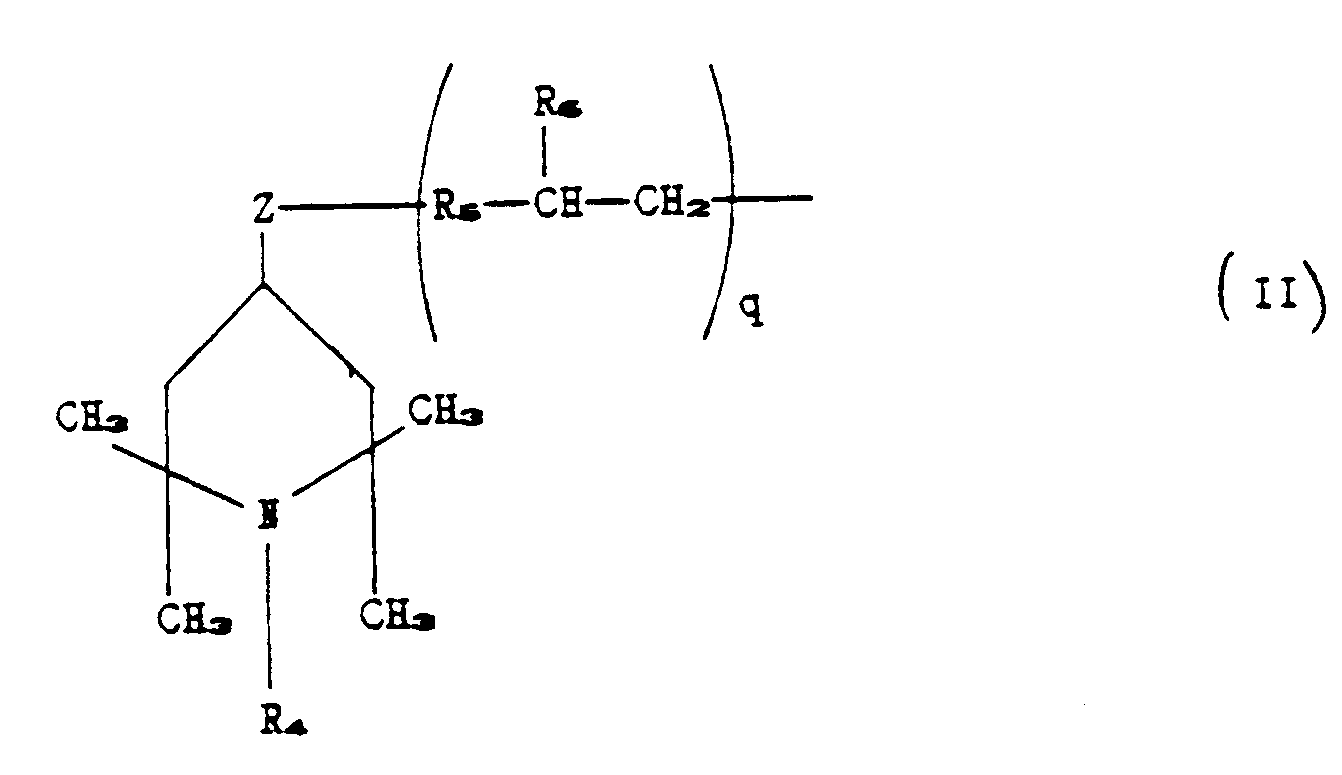
in which:
R₄ is hydrogen or methyl or benzyl;
R₅ is a linear or branched C₁-C₇ alkylene radical;
R₆ is hydrogen or methyl;
z is a group chosen from:
-O-;
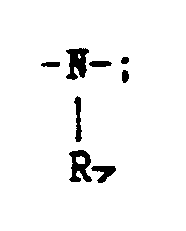
(where R₇ is a linear or branched C₁-C₅ alkyl group or hydrogen);
q is zero or one;
n is a whole number other than zero;
m and p, which can be the same or different, are zero or whole numbers, with the condition
that

is less than or equal to 50;
A is a group corresponding to the formula:

where R₁ has the aforesaid meaning;
B is a group corresponding to the formula:
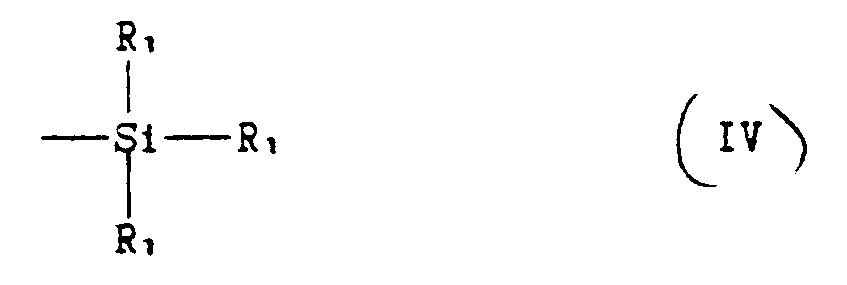
where R₁ has the aforesaid meaning;
or A and B jointly represent a direct bond, giving rise to a cyclic structure.
2. Stabilizer compounds as claimed in claim 1, characterised in that in formula (I) A
is a group corresponding to formula (III), B is a group corresponding to formula (IV),
and

is between 10 and 50.
3. Stabilizer compounds as claimed in claim 2, characterised in that in formula (I),
R₁ and R₃ are CH₃, R₂ is the group corresponding to the formula:

p is zero, and a and m vary from 5 to 15.
4. Stabilizer compounds as claimed in claim 2, characterised in that in formula (I),
R₁ is CH₃, R₂ is the group of formula (V), n varies from 30 to 40, and p and m are
zero.
5. Stabilizer compounds as claimed in claim 2, characterised in that in formula (I),
R₁ is CH₃, R₂ is the group of formula (V), R₃ is -(CH₂)₇-CH₃, p is zero, and m and
n vary from 15 to 20.
6. Stabilizer compounds as claimed in claim 2, characterised in that in formula (I),
R₁ is CH₃, R₂ is the group of formula (V), m is zero, p varies from 5 to 12, and n
varies from 25 to 30.
7. Stabilizer compounds as claimed in claim 2, characterised in that in formula (I),
R₁ and R₃ are CH₃, R₂ is the group:
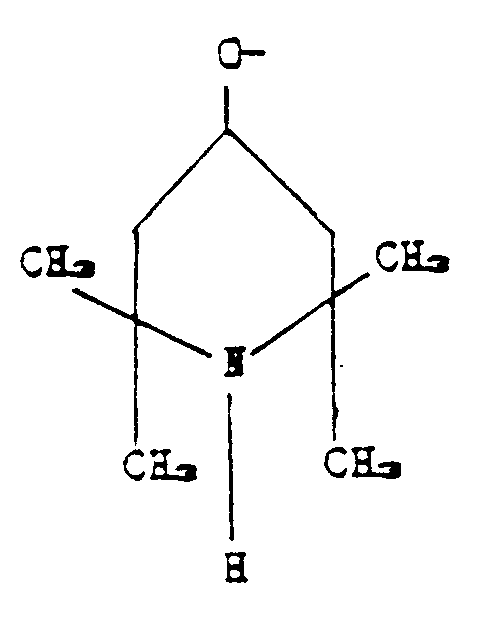
p is zero, a varies from 20 to 25, and m varies from 8 to 10.
8. Stabilizer compounds as claimed in claim 1, characterised in that in formula (I),
A and B jointly represent a direct bond, m and p are zero, and n varies from 4 to
7.
9. Stabilizer compounds as claimed in claim 8, characterised in that in formula (I),
R₁ is CH₃, and R₂ is the group of formula (V).
10. A method for preparing the stabilizer compounds claimed in claims 1 to 9 in which
R₂ is represented by formula (II) where q is one, characterised by bringing a polyorganosiloxane
compound corresponding to the formula:

where A, B, R₁, R₃, n, p and m have the aforesaid meanings,
into contact under reaction conditions with an unsaturated piperidino compound corresponding
to the formula:

in which R₄, R₅, R₆ and z have the aforesaid meanings,
until between 1 and n+p Si-H groups present in (VI) have undergone reaction.
11. A method as claimed in claim 10, characterised by operating at a temperature of between
0 and 140°C in the presence of a catalyst chosen from noble metal complexes in a concentration,
expressed as metal, of between 1 and 200 ppm in the reaction medium, in the absence
of solvent or in the presence of an inert organic solvent, for a time of between 1
and 10 hours.
12. A method as claimed in claim 11, characterised by operating at a temperature of between
80 and 120°C in the absence of a solvent and in the presence of a catalyst chosen
from Rh and Pt complexes in a concentration, expressed as metal, of between 5 and
50 ppm in the reaction medium.
13. A method as claimed in claim 11, characterised in that the catalyst is hexachloroplatinic
acid or rhodiumchloridephenylphosphine.
14. A method as claimed in claim 11, characterised in that the inert organic solvent is
chosen from aliphatic, cycloaliphatic and aromatic hydrocarbons.
15. A method as claimed in claim 14, characterised in that the solvent is toluene, heptane
or cyclohexane.
16. A method for preparing the stabilizer compounds claimed in claims 1 to 9 in which
R₂ is represented by formula (II) where q is zero, characterised by bringing a polyorganosiloxane
compound of the aforesaid formula (VI) into contact under reaction conditions with
a piperidino compound corresponding to the formula:
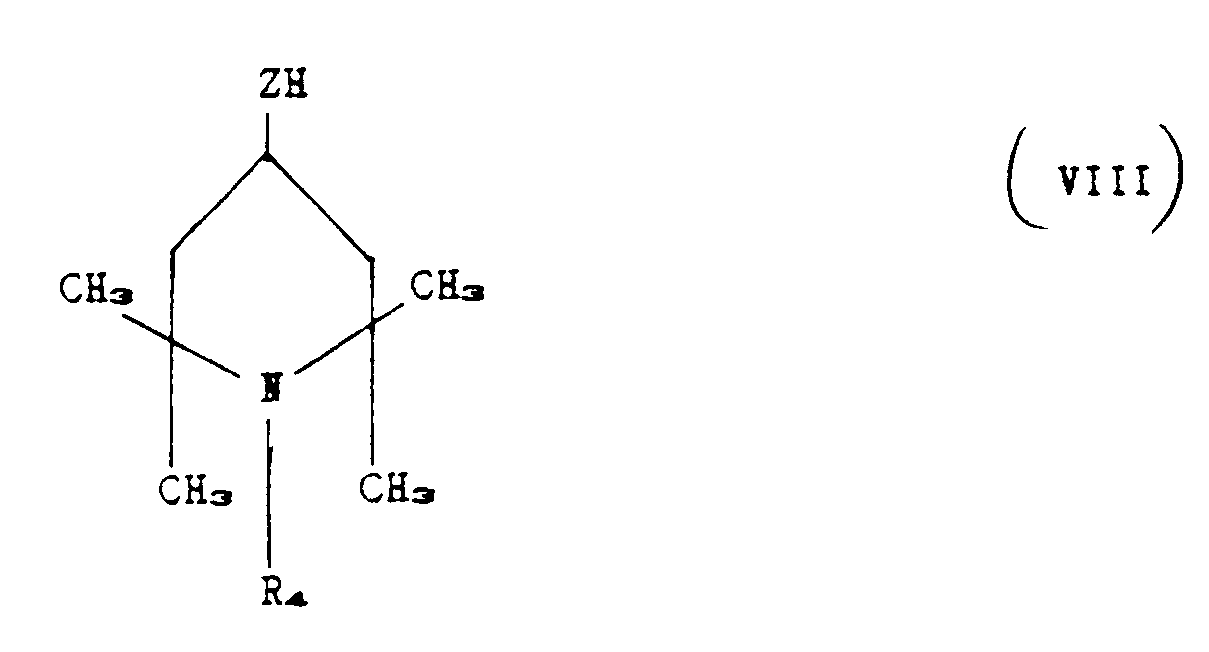
in which z and R₄ have the aforesaid meanings,
until between 1 and n+p Si-H groups present in (VI) have undergone reaction.
17. A method as claimed in claim 16, characterised by operating at a temperature of between
20 and 150°C in the presence of a catalyst chosen from metallic alcoholates or metal
salts of fatty acids in a quantity of between 0.01 and 5 mol% of compound (VIII),
in the presence of an inert organic solvent chosen from aliphatic and cycloaliphatic
hydrocarbons, for a time of between 1 and 10 hours.
18. A method as claimed in claim 17, characterised by operating at a temperature of between
60 and 120°C, using a catalyst quantity of between 0.1 and 1 mol% of compound (VIII).
19. A method as claimed in claim 17, characterised in that the catalyst is chosen from
sodium methylate, zinc octoate and tin octoate.
20. A method as claimed in claim 17, characterised in that the solvent is cyclohexane,
heptane or toluene.
21. A method for preparing the stabilizer compounds claimed in claims 1 to 9 in which
R₂ is represented by formula (II) where z is -O- and q is one, characterised by comprising
the following stages conducted in succession:
a) reacting a polyorganosiloxane compound represented by the aforesaid formula (VI)
with an unsaturated compound corresponding to the formula:
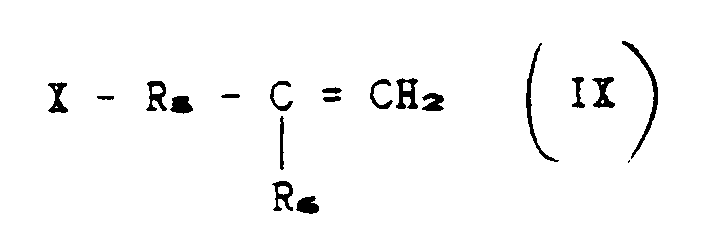
in which R₅ and R₆ have the aforesaid meaning and X = Cl or Br, to give a polyorganosiloxane
compound corresponding to the following formula:
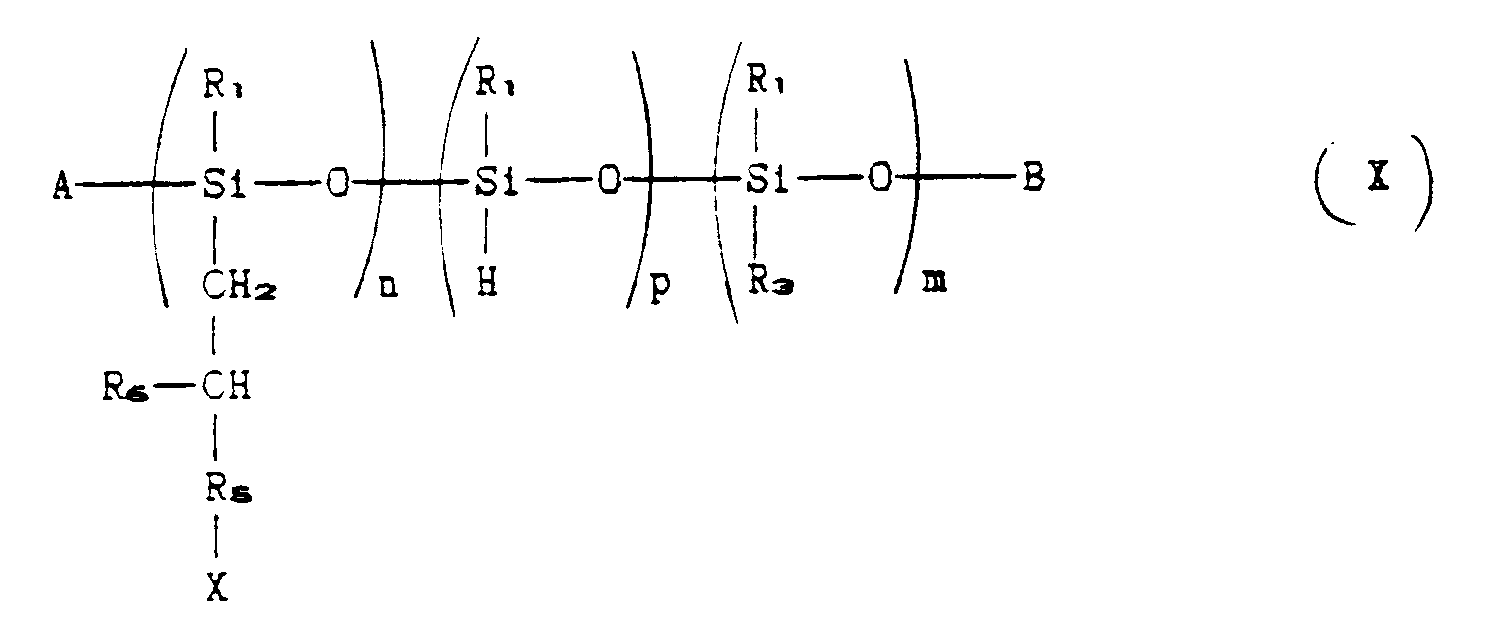
where R₁, R₃, R₅, R₆, A, B, X, n, p and m have the aforesaid meanings;
b) reacting compound (X) obtained in stage a) with a piperidino compound corresponding
to the formula:
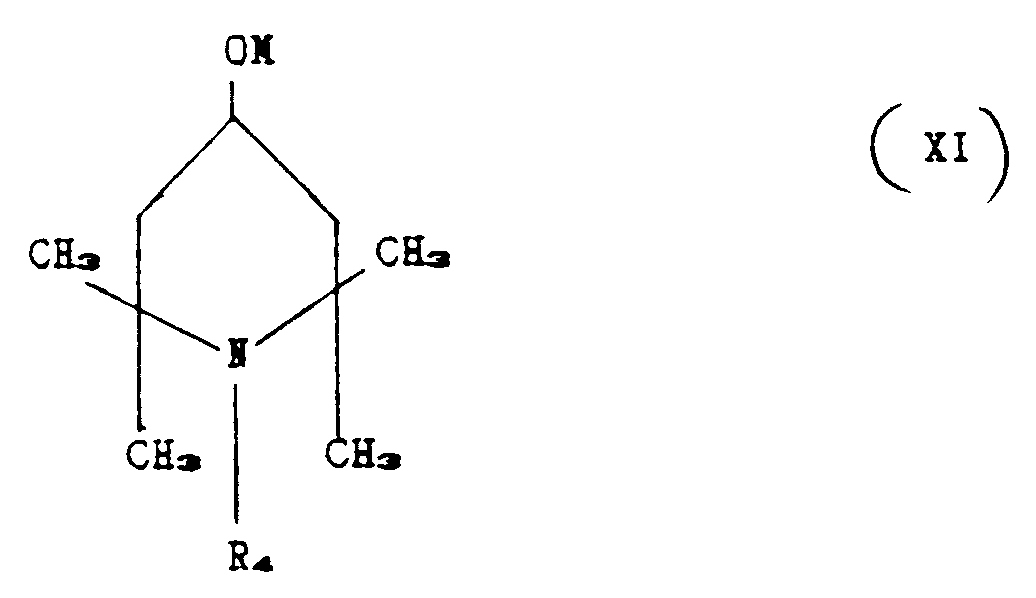
where R₄ has the aforesaid meaning, and M is Na, K or Li.
22. A method as claimed in claim 21, characterised by operating in stage a) at a temperature
of between 80 and 120°C for a time of between 1 and 10 hours in the presence of an
inert organic solvent chosen from aliphatic, cycloaliphatic and aromatic hydrocarbons,
using as catalyst a noble metal complex at a concentration, expressed as metal, of
between 1 and 200 ppm in the reaction medium.
23. A method as claimed in claim 22, characterised by operating in stage a) at a temperature
of between 80 and 120°C using as catalyst a Pt or Rh complex in a concentration of
between 5 and 50 ppm in the reaction medium.
24. A method as claimed in claim 22, characterised in that the catalyst is hexachloroplatinic
acid or rhodiumchloridephenylphosphine.
25. A method as claimed in claim 22, characterised in that the inert solvent is toluene,
heptane or cyclohexane.
26. A method as claimed in claim 21, characterised by operating in stage b) at a temperature
of between 25 and 80°C for a time of between 4 and 10 hours using a quantity of compound
(XI) which is stoichiometric with respect to compound (IX), in the presence of an
inert organic solvent chosen from aliphatic, cycloaliphatic and aromatic hydrocarbons.
27. Stabilized polymer compositions, characterized by comprising an organic polymer chosen
from olefin and diolefin homopolymers, copolymers of olefins with vinyl monomers,
polystyrene, copolymers and terpolymers of styrene with dienes or with acrylic monomers,
or polyurethanes, and a quantity of stabilizing compound claimed in claims 1 to 9
which provides between 0.0005% and 0.27% by weight of active nitrogen.
28. Stabilized polymer compositions as claimed in claim 27, characterized by comprising
an organic polymer and a quantity of stabilizing compound claimed in claims 1 to 5
which provides between 0.003% and 0.054 % by weight of active nitrogen.
29. Stabilized polymer compositions as claimed in claims 27 and 28, characterized by additionally
containing other UV stabilizers and/or other additives commonly used in the art, in
a quantity of between 0.01% and 5% by weight with respect to the organic polymer.
30. Stabilized polymer compositions as claimed in claims 27 to 29, characterised in that
the stabilizer compound is fixed to a solid support containing surface hydroxyl groups.
31. Stabilized polymer compositions as claimed in claim 30, characterised in that the
solid support is a natural or synthetic siliceous material or TiO₂.
32. Stabilized polymer compositions as claimed in claim 31, characterised in that the
solid support is glass fibre, silica gel, talc, kaolin, mica, celite, diatomaceous
earth or TiO₂.
33. Stabilized polymer compositions as claimed in claim 27, characterised in that the
organic polymer is polypropylene, low or high density polyethylene, low density linear
polyethylene, polybutadiene or polyurethane.
Claims for the following Contracting State(s): ES
1. A method for preparing Polymeric stabilizer compounds having the general formula:

where:
R₁ and R₃ , which can be the same or different, are linear or branched C₁-C₁₀ alkyl
radicals or C₅-C₁₁ cycloaliphatic radicals or phenyl radicals;
R₂ is a radical chosen from those corresponding to the following formula:

in which:
R₄ is hydrogen or methyl or benzyl;
R₅ is a linear or branched C₁-C₇ alkalene radical;
R₆ is hydrogen or methyl;
z is a group chosen from:
-O-;
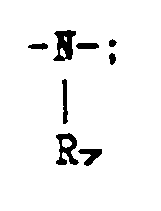
(where R₇ is a linear or branched C₁-C₅ alkyl group or hydrogen);
q is zero or one;
n is a whole number other than zero;
m and p, which can be the same or different, are zero or whole numbers, with the condition
that

is less than or equal to 50;
A is a group corresponding to the formula:

where R₁ has the aforesaid meaning;
B is a group corresponding to the formula:
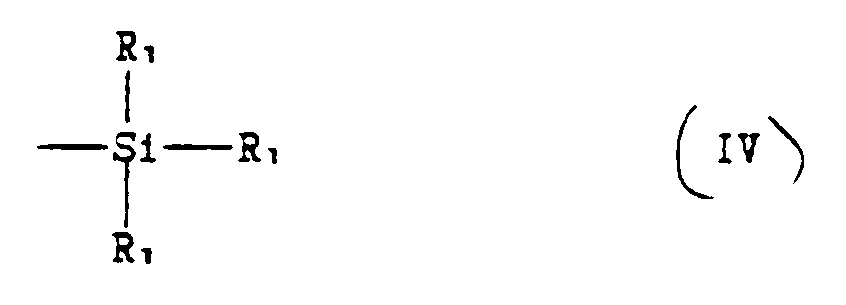
where R₁ has the aforesaid meaning;
or A and B jointly represent a direct bond, giving rise to a cyclic structure,
characterized by
bringing a polyorganosiloxane compound corresponding to the formula:

where A, B, R₁, R₃, n, p and m have the aforesaid meanings, into contact under reaction
conditions with
a) an unsaturated piperidino compound corresponding to the formula

in which R₄, R₅, R₆ and Z have the aforesaid meanings, when R₂ is represented by
the formula (II) where q is one,
or
b) an unsaturated piperidino compound corresponding to the formula:

in which Z and R₄ have the afore said meanings, when R₂ is represented by the formula
(II) where q is zero,
until between 1 and n+p Si-H groups present in (VI) have undergone reaction.
2. A method as claimed in claim 1, characterised in that in formula (I) A is a group
corresponding to formula (III), B is a group corresponding to formula (IV), and

is between 10 and 50.
3. A method as claimed in claim 2, characterised in that in formula (I), R₁ and R₃ are
CH₃, R₂ is the group corresponding to the formula:

p is zero, and n and m vary from 5 to 15.
4. A method as claimed in claim 2, characterised in that in formula (I), R₁ is Ch₃, R₂
is the group of formula (V), n varies from 30 to 40, and p and m are zero.
5. A method as claimed in claim 2, characterised in that in formula (I), R₁ is CH₃, R₂
is the group of formula (V), R₃ is -(CH₂)₇-CH₃, p is zero, and m and n vary from 15
to 20.
6. A method as claimed in claim 2, characterised in that in formula (I), R₁ is CH₃, R₂
is the group of formula (V), m is zero, p varies from 5 to 12, and n varies from 25
to 30.
7. A method as claimed in claim 2, characterised in that in formula (I), R₁ and R₃ are
CH₃, R₂ is the group:
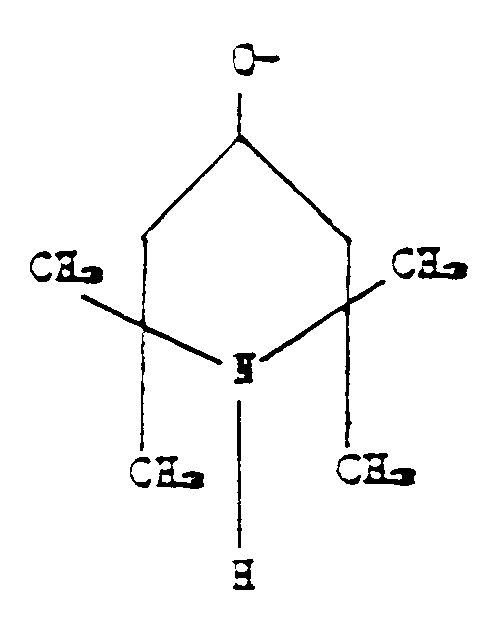
p is zero, n varies from 20 to 25, and m varies from 8 to 10.
8. A method as claimed in claim 1, characterised in that in formula (I), A and B jointly
represent a direct bond, m and p are zero, and n varies from 4 to 7.
9. A method as claimed in claim 8, characterised in that in formula (I), R₁ is CH₃, and
R₂ is the group of formula (V).
10. A method as claimed in claim 1, characterised by operating at a temperature of between
0 and 140°C in the presence of a catalyst chosen from noble metal complexes in a concentration,
expressed as metal, of between 1 and 200 ppm in the reaction medium, in the absence
of solvent or in the presence of an inert organic solvent, for a time of between 1
and 10 hours, being 9 equal to one.
11. A method as claimed in claim 10, characterised by operating at a temperature of between
80 and 120°C in the absence of a solvent and in the presence of a catalyst chosen
from Rh and Pt complexes in a concentration, expressed as metal, of between 5 and
50 ppm in the reaction medium.
12. A method as claimed in claim 10, characterised in that the catalyst is hexachloroplatinic
acid or rhodiumchloridephenylphosphine.
13. A method as claimed in claim 10, characterised in that the inert organic solvent is
chosen from aliphatic, cycloaliphatic and aromatic hydrocarbons.
14. A method as claimed in claim 13, characterised in that the solvent is toluene, heptane
or cyclohexane.
15. A method as claimed in claim 1, characterised by operating at a temperature of between
20 and 150°C in the presence of a catalyst chosen from metallic alcoholates or metal
salts of fatty acids in a quantity of between 0.01 and 5 mol% of compound (VIII),
in the presence of an inert organic solvent chosen from aliphatic and cycloaliphatic
hydrocarbons, for a time of between 1 and 10 hours, being 9 equal to zero.
16. A method as claimed in claim 15, characterised by operating at a temperature of between
60 and 120°C, using a catalyst quantity of between 0.1 and 1 mol% of compound (VIII).
17. A method as claimed in claim 15, characterised in that the catalyst is chosen from
sodium methylate, zinc octoate and tin octoate.
18. A method as claimed in claim 15, characterised in that the solvent is cyclohexane,
heptane or toluene.
19. A method for preparing stabilized polymer compositions, characterized by comprising
the step of combining together an organic polymer chosen from olefin and diolefin
homopolymers, copolymers of olefins with vinyl monomers, polystyrene, copolymers and
terpolymers of styrene with dienes or with acrylic monomers, or polyurethanes, and
a quantity of stabilizing compound prepared according to claims 1 to 9 which provides
between 0.0005% and 0.27% by weight of active nitrogen.
20. A method for preparing stabilized polymer compositions as claimed in claim 19, characterized
by comprising the step of combining together an organic polymer and a quantity of
stabilizing compound prepared according to claims 1 to 5 which provides between 0.003%
and 0.054 % by weight of active nitrogen.
21. A method as claimed in claims 19 and 20, characterized by additionally containing
other UV stabilizers and/or other additives commonly used in the art, in a quantity
of between 0.01% and 5% by weight with respect to the organic polymer.
22. A method as claimed in claims 19 to 21, characterised in that the stabilizer compound
is fixed to a solid support containing surface hydroxyl groups.
23. A method as claimed in claim 22, characterised in that the solid support is a natural
or synthetic siliceous material or TiO₂.
24. A method as claimed in claim 23, characterised in that the solid support is glass
fibre, silica gel, talc, kaolin, mica, celite, diatomaceous earth or TiO₂.
25. A method as claimed in claim 19, characterised in that the organic polymer is polypropylene,
low or high density polyethylene, low density linear polyethylene, polybutadiene or
polyurethane.
Patentansprüche für folgende(n) Vertragsstaat(en): AT, BE, FR, DE, GB, GR, LU, NL,
SE, CH, LI
1. Polymere Stabilisatorverbindungen mit der allgemeinen Formel:

worin:
R₁ und R₃ , die gleich oder verschieden sein können, gerade oder verzweigte C₁-C₁₀-Alkylreste
oder C₅-C₁₁ cykloaliphatische Reste oder Phenylreste darstellen;
R₂ einen Rest bedeutet, ausgewählt unter jenen, die der folgenden Formel:
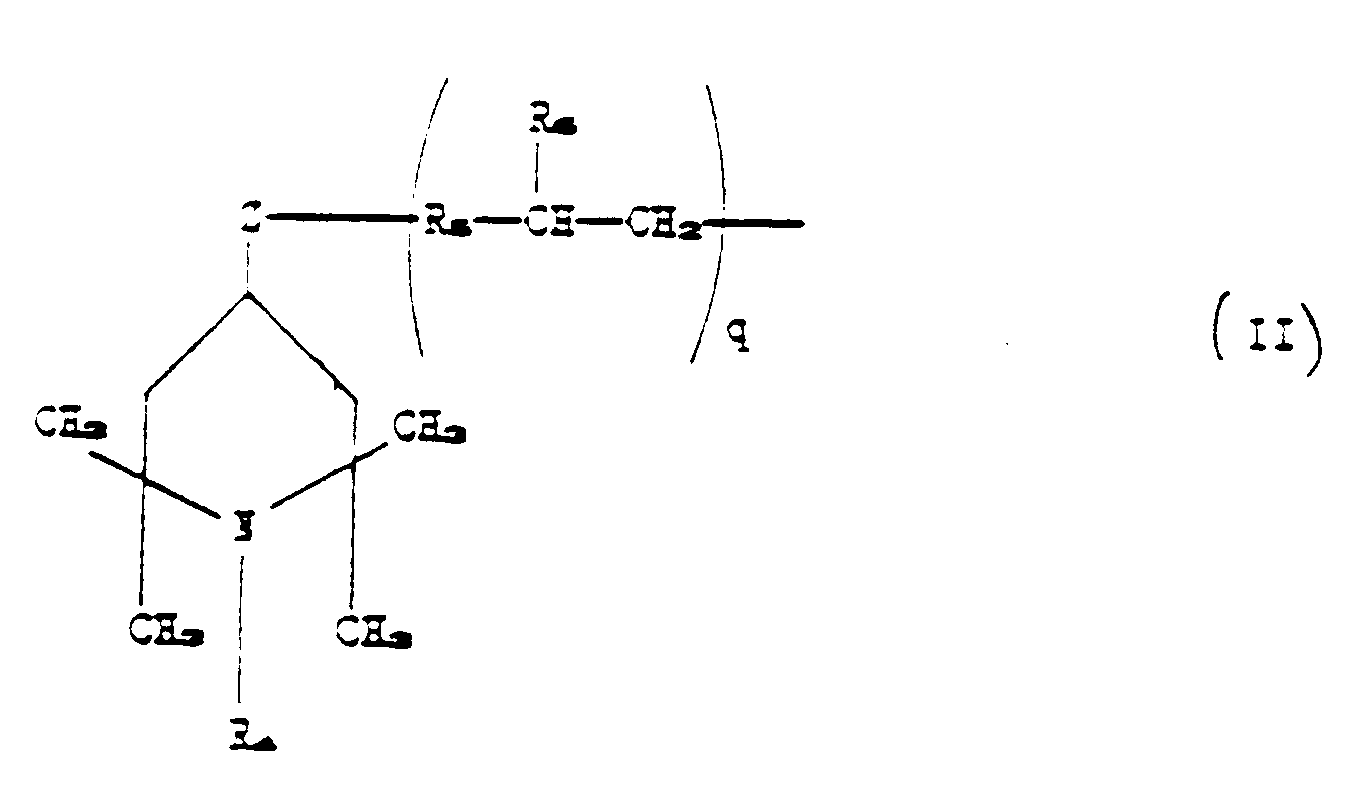
entsprechen, worin:
R₄ Wasserstoff oder Methyl oder Benzyl bedeutet;
R₅ einen geraden oder verzweigten C₁-C₇-Alkylenrest bezeichnet;
R₆ Wasserstoff oder Methyl darstellt;
Z für eine unter
-O- und
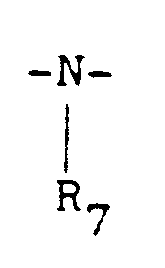
ausgewählte Gruppe steht, worin:
R₇ eine gerade oder verzweigte C₁-C₅-Alkylgruppe oder Wasserstoff ist;
q 0 oder 1 ist;
n eine ganze,von 0 verschiedene Zahl ist;
m und p, die gleich oder verschieden sein können, 0 oder ganze Zahlen sind, mit der
Maßgabe, daß

kleiner als oder gleich 50 ist;
A für eine Gruppe entsprechend der Formel:

steht, worin R₁ die vorstehend angegebenen Bedeutung aufweist;
B für eine Gruppe entsprechend der Formel:

steht, worin R₁ die oben angeführte Bedeutung hat;
oder A und B gemeinsam eine direkte Bindung darstellen, unter Ausbildung einer zyklischen
Struktur.
2. Stabilisatorverbindungen nach Anspruch 1, dadurch gekennzeichnet, daß in Formel (I)
A eine Gruppe entsprechend Formel (III) ist, B eine Gruppe entsprechend Formel (IV)
ist und

einen Wert zwischen 10 und 50 aufweist.
3. Stabilisatorverbindungen nach Anspruch 2, dadurch gekennzeichnet, daß in Formel (I)
R₁ und R₃ CH₃ bedeuten, R₂ die der Formel:
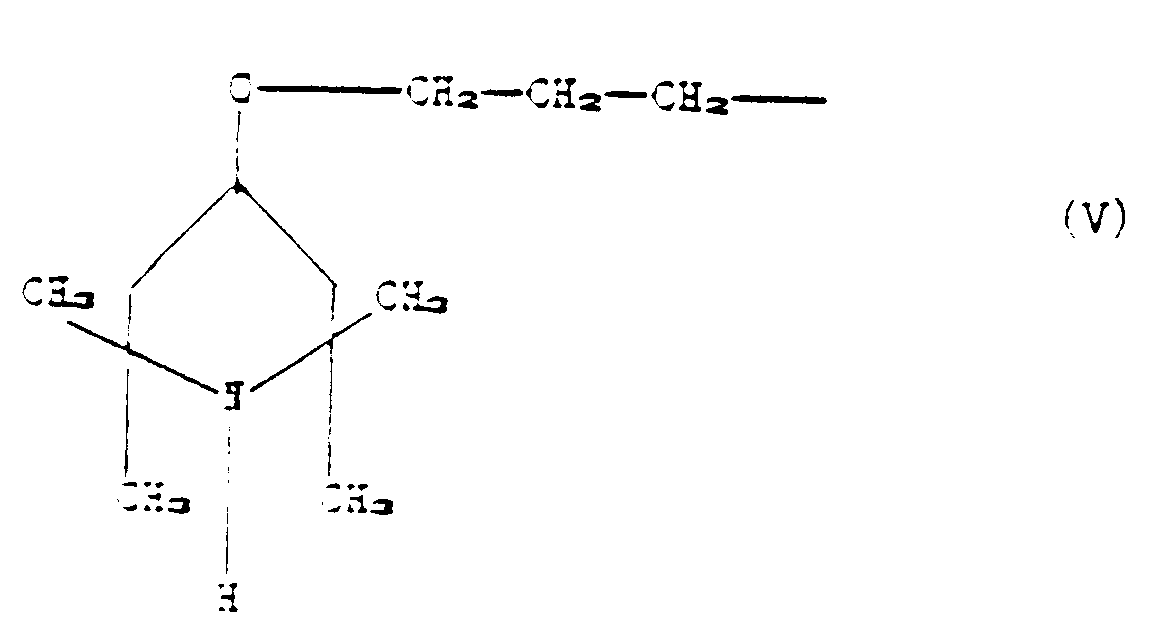
entsprechende Gruppe ist, p den Wert 0 hat und n und m von 5 bis 15 variieren.
4. Stabilisatorverbindungen nach Anspruch 2, dadurch gekennzeichnet, daß in Formel (I)
R₁ CH₃ bedeutet, R₂ die Gruppe der Formel (V) darstellt, n von 30 bis 40 variiert
und p und m 0 sind.
5. Stabilisatorverbindungen nach Anspruch 2, dadurch gekennzeichnet, daß in Formel (I)
R₁ CH₃ bedeutet, R₂ die Gruppe der Formel ( V) ist, R₃ für -(CH₂)₇-CH₃ steht, p den
Wert 0 hat und m und n von 15 bis 20 variieren.
6. Stabilisatorverbindungen nach Anspruch 2, dadurch gekennzeichnet, daß in Formel (I)
R₁ für CH₃ steht, R₂ die Gruppe der Formel (V) ist, m den Wert 0 hat, p von 5 bis
12 variiert und n von 25 bis 30 variiert.
7. Stabilisatorverbindungen nach Anspruch 2, dadurch gekennzeichnet, daß in Formel (I)
R₁ und R₃ CH₃ bedeuten, R₂ die Gruppe
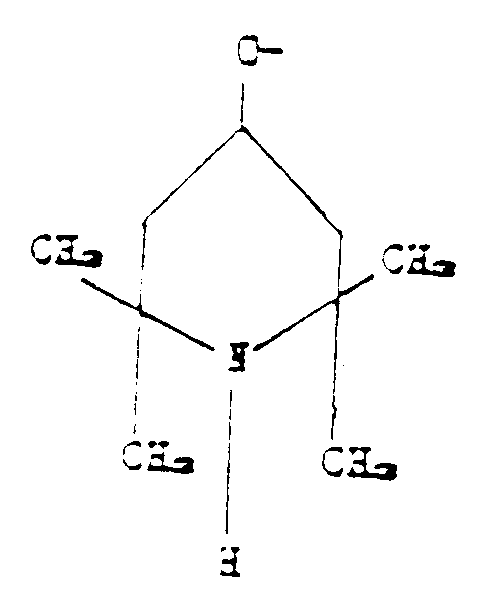
ist, p den Wert 0 hat, n von 20 bis 25 variiert und m von 8 bis 10 variiert.
8. Stabilisatorverbindungen nach Anspruch 1, dadurch gekennzeichnet, daß in Formel (I)
A und B gemeinsam eine direkte Bindung darstellen, m und p 0 sind und n von 4 bis
7 variiert.
9. Stabilisatorverbindungen nach Anspruch 8, dadurch gekennzeichnet, daß in Formel (I)
R₁ für CH₃ steht und R₂ die Gruppe der Formel (V) ist.
10. Verfahren zur Herstellung der Stabilisatorverbindungen nach den Ansprüchen 1 bis 9,
worin R₂ durch Formel (II) dargestellt ist, worin q den Wert 1 hat, dadurch gekennzeichnet,
daß eine Polyorganosiloxanverbindung entsprechend der Formel:

worin A, B, R₁, R₃, n, p und m die oben genannten Bedeutungen aufweisen, unter Reaktionsbedingungen
mit einer ungesättigten Piperidinoverbindung entsprechend der Formel:
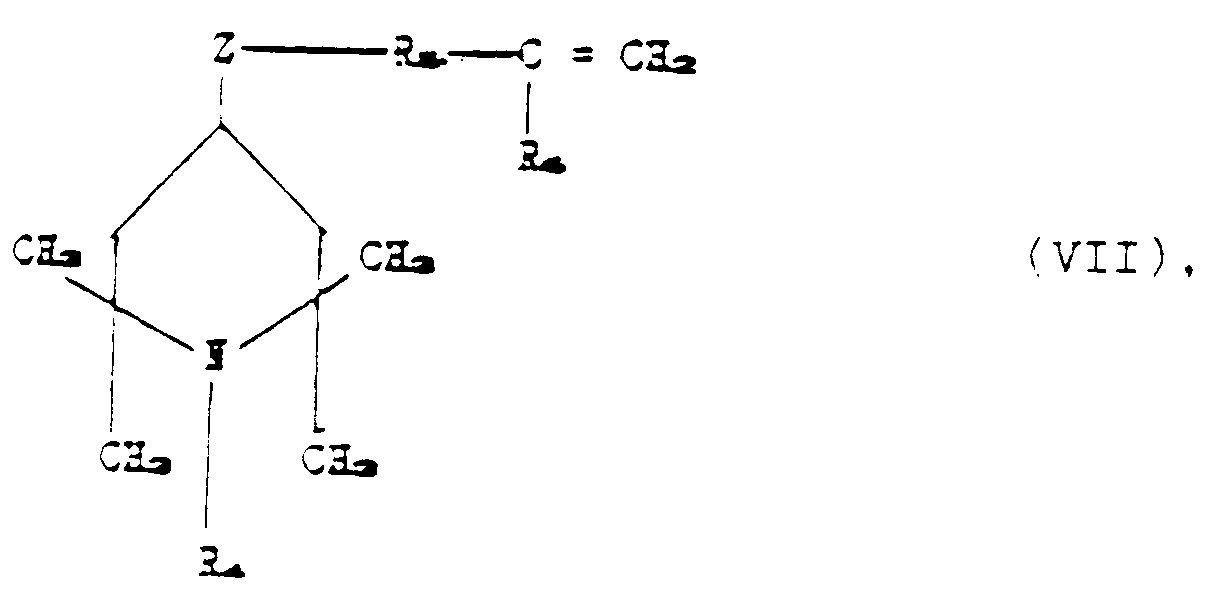
worin R₄, R₅, R₆ und Z die oben genannten Bedeutungen aufweisen, in Kontakt gebracht
wird, bis zwischen einer und n+p der in (VI) vorliegenden Si-H-Gruppen reagiert haben.
11. Verfahren nach Anspruch 10, gekennzeichnet durch Arbeiten bei einer Temperatur zwischen
0 und 140°C in Gegenwart eines unter Edelmetallkomplexen ausgewählten Katalysators
in einer Konzentration, ausgedrückt als Metall, zwischen 1 und 200 ppm im Reaktionsmedium,
in Abwesenheit von Lösungsmittel oder in Gegenwart eines inerten organischen Lösungsmittels
während einer Zeit zwischen 1 und 10 h.
12. Verfahren nach Anspruch 11, gekennzeichnet durch Arbeiten bei einer Temperatur zwischen
80 und 120°C in Abwesenheit eines Lösungsmittels und in Gegenwart eines unter Rhodium-
und Platinkomplexen ausgewählten Katalysators in einer Konzentration, ausgedrückt
als Metall, zwischen 5 und 50 ppm im Reaktionsmedium.
13. Verfahren nach Anspruch 11, dadurch gekennzeichnet, daß der Katalysator Hexachlorplatinsäure
oder Rhodiumchloridphenylphosphin ist.
14. Verfahren nach Anspruch 11, dadurch gekennzeichnet, daß das inerte organische Lösungsmittel
unter aliphatischen, cykloaliphatischen und aromatischen Kohlenwasserstoffen ausgewählt
ist.
15. Verfahren nach Anspruch 14, dadurch gekennzeichnet, daß das Lösungsmittel Toluol,
Heptan oder Cyklohexan ist.
16. Verfahren zur Herstellung der Stabilisatorverbindungen nach den Ansprüchen 1 bis 9,
worin R₂ durch Formel (II) dargestellt ist, worin q 0 ist, dadurch gekennzeichnet,
daß eine Polyorganosiloxanverbindung der vorstehenden Formel (VI) unter Reaktionsbedingungen
mit einer Piperidinoverbindung entsprechend der Formel:

worin Z und R₄ die oben angeführten Bedeutungen aufweisen, in Kontakt gebracht wird,
bis zwischen 1 und n+p der in (VI) vorliegenden Si-H-Gruppen reagiert haben.
17. Verfahren nach Anspruch 16, gekennzeichnet durch Arbeiten bei einer Temperatur zwischen
20 und 150°C in Gegenwart eines unter Metallalkoholaten oder Metallsalzen von Fettsäuren
gewählten Katalysators in einer Menge zwischen 0,01 und 5 Mol-% der Verbindung (VIII)
in Gegenwart eines unter aliphatischen und cykloaliphatischen Kohlenwasserstoffen
ausgewählten organischen Lösungsmittels während einer Zeit von 1 bis 10 h.
18. Verfahren nach Anspruch 17, gekennzeichnet durch Arbeiten bei einer Temperatur zwischen
60 und 120°C unter Anwendung einer Katalysatormenge zwischen 0,1 und 1 Mol-% der Verbindung
(VIII).
19. Verfahren nach Anspruch 17, dadurch gekennzeichnet, daß der Katalysator unter Natriummethylat,
Zinkoctoat und Zinnoctoat ausgewählt ist.
20. Verfahren nach Anspruch 17, dadurch gekennzeichnet, daß das Lösungsmittel Cyklohexan,
Heptan oder Toluol ist.
21. Verfahren zur Herstellung der Stabilisatorverbindungen nach den Ansprüchen 1 bis 9,
worin R₂ durch Formel (II) dargestellt ist, worin Z für -O- steht und q 1 ist, dadurch
gekennzeichnet, daß es die folgenden, aufeinanderfolgend ausgeführten Stufen umfaßt:
a) Umsetzen einer Polyorganosiloxanverbindung, dargestellt durch die vorstehend genannte
Formel (VI), mit einer ungesättigten Verbindung entsprechend der Formel:

worin R₅ und R₆ die oben genannten Bedeutungen aufweisen und X für Cl oder Br steht,
unter Ausbildung einer Polyorganosiloxanverbindung entsprechend der nachstehenden
Formel:
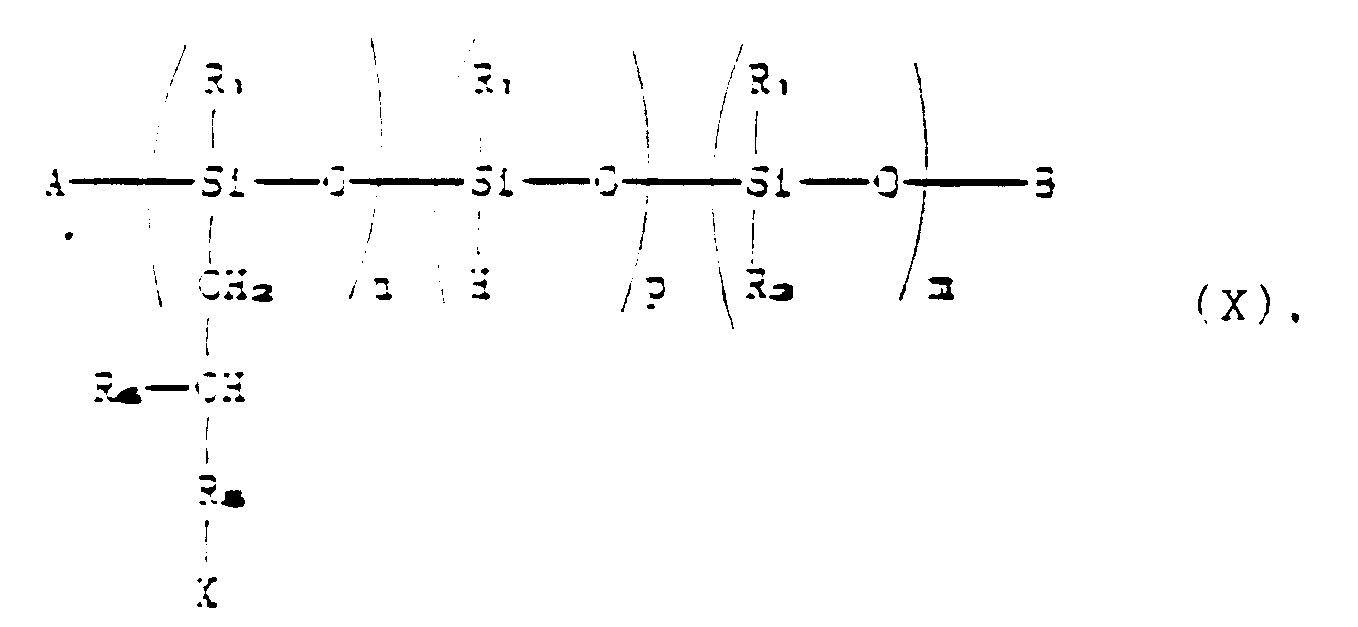
worin R₁, R₃, R₅, R₆, A, B, X, n, p und m die oben angeführten Bedeutungen aufweisen;
b) Umsetzen der in Stufe a) erhaltenen Verbindung (X) mit einer Piperidinoverbindung
entsprechend der Formel:
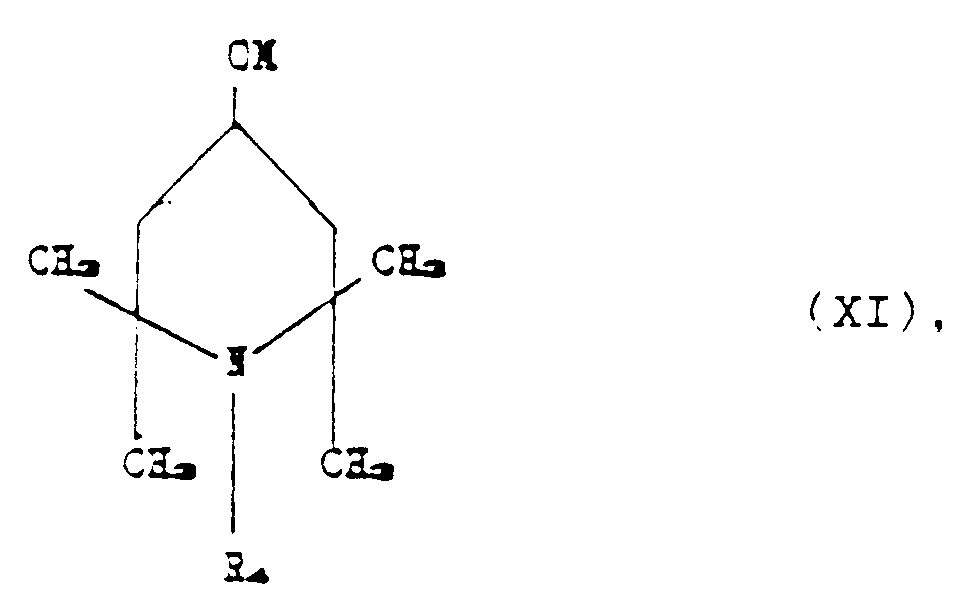
worin R₄ die vorstehend genannte Bedeutung aufweist und M für Na, K oder Li steht.
22. Verfahren nach Anspruch 21, dadurch gekennzeichnet, daß in Stufe a) bei einer Temperatur
zwischen 80 und 120°C während einer Zeit zwischen 1 und 10 Stunden in Gegenwart eines
inerten organischen Lösungsmittels, ausgewählt unter aliphatischen, cykloaliphatischen
und aromatischen Kohlenwasserstoffen, unter Verwendung eines Edelmetallkomplexes als
Katalysator bei einer Konzentration, ausgedrückt als Metall, zwischen 1 und 200 ppm
im Reaktionsmedium gearbeitet wird.
23. Verfahren nach Anspruch 22, dadurch gekennzeichnet, daß in Stufe a) bei einer Temperatur
zwischen 80 und 120°C unter Verwendung eines Platin- oder Rhodiumkomplexes als Katalysator
in einer Konzentration zwischen 5 und 50 ppm im Reaktionsmedium gearbeitet wird.
24. Verfahren nach Anspruch 22, dadurch gekennzeichnet, daß der Katalysator Hexachlorplatinsäure
oder Rhodiumchloridphenylphosphin ist.
25. Verfahren nach Anspruch 22, dadurch gekennzeichnet, daß das inerte Lösungsmittel Toluol,
Heptan oder Cyklohexan ist.
26. Verfahren nach Anspruch 21, dadurch gekennzeichnet, daß in Stufe b) bei einer Temperatur
zwischen 25 und 80°C während einer Zeit zwischen 4 und 10 h unter Anwendung einer
Menge an Verbindung (XI), die hinsichtlich der Verbindung (IX) stöchiometrisch ist,
in Gegenwart eines inerten, unter aliphatischen, cykloaliphatischen und aromatischen
Kohlenwasserstoffen ausgewählten organischen Lösungsmittels gearbeitet wird.
27. Stabilisierte Polymerzusammensetzungen, dadurch gekennzeichnet, daß sie ein organisches,
unter Olefin- und Diolefinhomopolymeren, Copolymeren von Olefinen mit Vinylmonomeren,
Polystyrol, Copolymeren und Terpolymeren von Styrol mit Dienen oder mit Acrylmonomeren
oder Polyurethanen ausgewähltes Polymer und eine Menge an stabilisierender Verbindung
nach den Ansprüchen 1 bis 9 umfaßt, die zwischen 0,0005 und 0,27 Gew.-% aktiven Stickstoff
ergibt.
28. Stabilisierte Polymerzusammensetzungen nach Anspruch 27, dadurch gekennzeichnet, daß
sie ein organisches Polymer und eine Menge an stabilisierender Verbindung nach den
Ansprüchen 1 bis 5 umfaßt, die zwischen 0,003 und 0,054 Gew.- % aktiven Stickstoff
ergibt.
29. Stabilisierte Polymerzusammensetzungen nach den Ansprüchen 27 und 28, dadurch gekennzeichnet,
daß sie zusätzlich andere UV-Stabilisatoren und/oder andere, in der Technik üblicherweise
verwendete Additive in einer Menge zwischen 0,01 und 5 Gew.-%, bezogen auf das organische
Polymer, enthält.
30. Stabilisierte Polymerzusammensetzungen nach den Ansprüchen 27 bis 29, dadurch gekennzeichnet,
daß die Stabilisatorverbindung an einem festen, Oberflächenhydroxylgruppen enthaltenden
Träger fixiert ist.
31. Stabilisierte Polymerzusammensetzungen nach Anspruch 30, dadurch gekennzeichnet, daß
der feste Träger ein natürliches oder synthetisches kieselsäurehältiges Material oder
TiO₂ ist.
32. Stabilisierte Polymerzusammensetzungen nach Anspruch 31, dadurch gekennzeichnet, daß
der feste Träger Glasfaser, Siliciumdioxidgel, Talk, Kaolin, Glimmer, Celit, Diatomeenerde
oder TiO₂ ist.
33. Stabilisierte Polymerzusammensetzungen nach Anspruch 27, dadurch gekennzeichnet, daß
das organische Polymer Polypropylen, Polyethylen niedriger oder hoher Dichte, lineares
Polyethylen niedriger Dichte, Polybutadien oder Polyurethan ist.
Patentansprüche für folgende(n) Vertragsstaat(en): ES
1. Verfahren zur Herstellung von polymeren Stabilisatorverbindungen mit der allgemeinen
Formel:

worin:
R₁ und R₃ , die gleich oder verschieden sein können, gerade oder verzweigte C₁-C₁₀-Alkylreste
oder C₅-C₁₁ cykloaliphatische Reste oder Phenylreste darstellen;
R₂ einen Rest bedeutet, ausgewählt unter jenen, die der folgenden Formel:

entsprechen, worin:
R₄ Wasserstoff oder Methyl oder Benzyl bedeutet;
R₅ einen geraden oder verzweigten C₁-C₇-Alkylenrest bezeichnet;
R₆ Wasserstoff oder Methyl darstellt;
Z für eine unter
-O- und
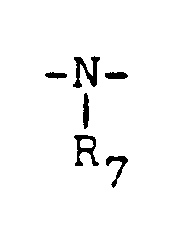
ausgewählte Gruppe steht, worin:
R₇ eine gerade oder verzweigte C₁-C₅-Alkylgruppe oder Wasserstoff ist;
q 0 oder 1 ist;
n eine ganze, von 0 verschiedene Zahl ist;
m und p, die gleich oder verschieden sein können, 0 oder ganze Zahlen sind, mit der
Maßgabe, daß

kleiner als oder gleich 50 ist;
A für eine Gruppe entsprechend der Formel:

steht, worin R₁ die vorstehend angegebenen Bedeutung aufweist;
B für eine Gruppe entsprechend der Formel:

steht, worin R₁ die oben angeführte Bedeutung hat;
oder A und B gemeinsam eine direkte Bindung darstellen, unter Ausbildung einer zyklischen
Struktur, dadurch gekennzeichnet, daß eine Polyorganosiloxanverbindung entsprechend
der Formel:

worin A, B, R₁, R₃, n, p und m die oben genannten Bedeutungen aufweisen, unter Reaktionsbedingungen
mit einer ungesättigten Piperidinoverbindung entsprechend der Formel:

worin R₄, R₅, R₆ und Z die oben genannten Bedeutungen aufweisen, wenn R₂ der Formel
(II), wobei q eins ist, entspricht oder
mit einer ungesaettigten Piperidinoverbindung entsprechend der Formel
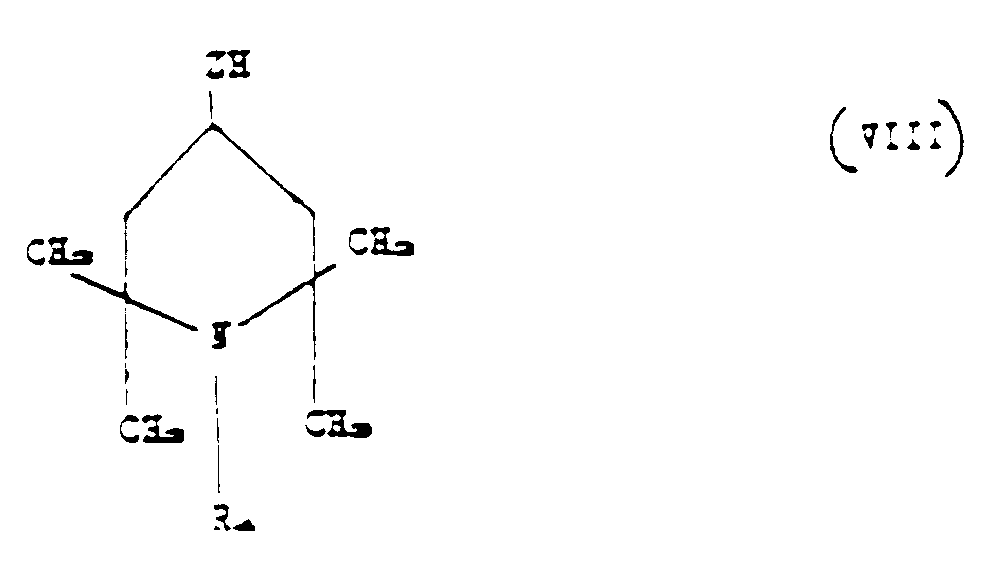
worin Z und R₄ die oben genannten Bedeutungen aufweisen, wenn R₂ der Formel (II),
wobei q null ist, entspricht, in Kontakt gebracht wird, bis zwischen .. einer und
n+p der in (VI) vorliegenden Si-H-Gruppen reagiert haben.
2. Verfahren nach Anspruch 1, dadurch gekennzeichnet, daß in Formel (I) A eine Gruppe
entsprechend Formel (III) ist, B eine Gruppe entsprechend Formel (IV) ist und

einen Wert zwischen 10 und 50 aufweist.
3. Verfahren nach Anspruch 2, dadurch gekennzeichnet, daß in Formel (I) R₁ und R₃ CH₃
bedeuten, R₂ die der Formel:
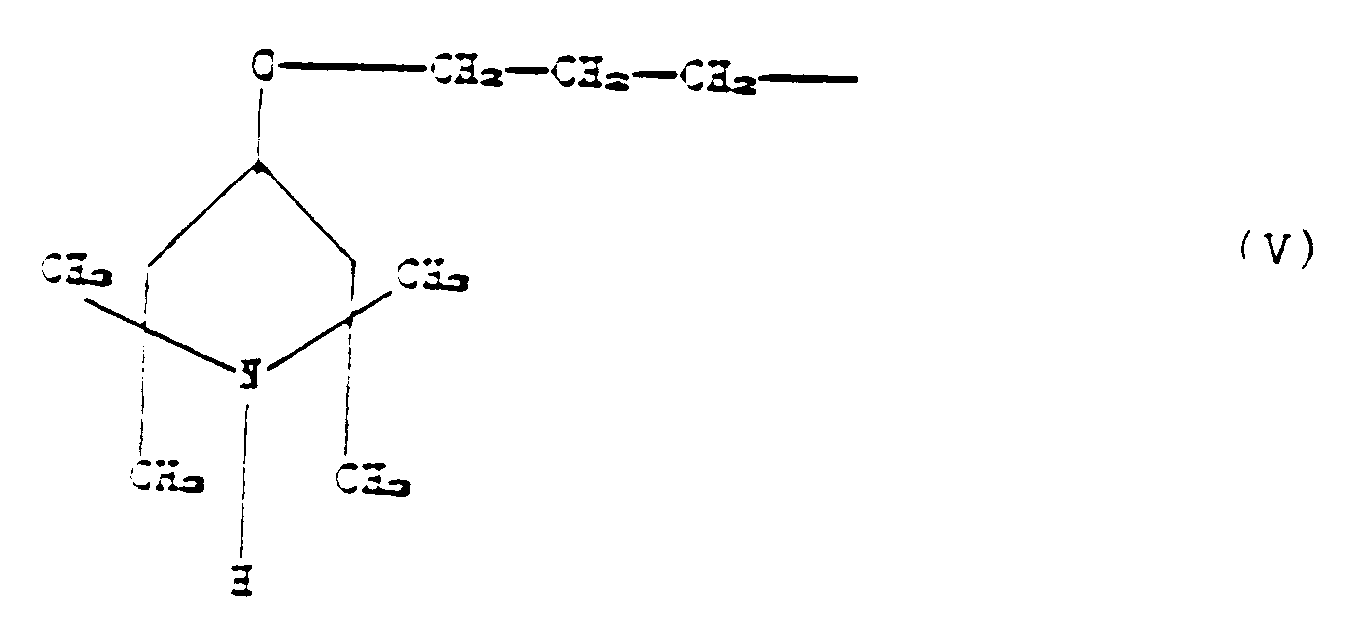
entsprechende Gruppe ist, p den Wert 0 hat und n und m von 5 bis 15 variieren.
4. Verfahren nach Anspruch 2, dadurch gekennzeichnet, daß in Formel (I) R₁ CH₃ bedeutet,
R₂ die Gruppe der Formel (V) darstellt, n von 30 bis 40 variiert und p und m 0 sind.
5. Verfahren nach Anspruch 2, dadurch gekennzeichnet, daß in Formel (I) R₁ CH₃ bedeutet,
R₂ die Gruppe der Formel ( V) ist, R₃ für -(CH₂)₇-CH₃ steht, p den Wert 0 hat und
m und n von 15 bis 20 variieren.
6. Verfahren nach Anspruch 2, dadurch gekennzeichnet, daß in Formel (I) R₁ für CH₃ steht,
R₂ die Gruppe der Formel (V) ist, m den Wert 0 hat, p von 5 bis 12 variiert und n
von 25 bis 30 variiert.
7. Verfahren nach Anspruch 2, dadurch gekennzeichnet, daß in Formel (I) R₁ und R₃ CH₃
bedeuten, R₂ die Gruppe

ist, p den Wert 0 hat, n von 20 bis 25 variiert und m von 8 bis 10 variiert.
8. Verfahren nach Anspruch 1, dadurch gekennzeichnet, daß in Formel (I) A und B gemeinsam
eine direkte Bindung darstellen, m und p 0 sind und n von 4 bis 7 variiert.
9. Verfahren nach Anspruch 8, dadurch gekennzeichnet, daß in Formel (I) R₁ für CH₃ steht
und R₂ die Gruppe der Formel (V) ist.
10. Verfahren nach Anspruch 1, gekennzeichnet durch Arbeiten bei einer Temperatur zwischen
0 und 140°C in Gegenwart eines unter Edelmetallkomplexen ausgewählten Katalysators
in einer Konzentration, ausgedrückt als Metall, zwischen 1 und 200 ppm im Reaktionsmedium,
in Abwesenheit von Lösungsmittel oder in Gegenwart eines inerten organischen Lösungsmittels
während einer Zeit zwischen 1 und 10 h, wobei q den wert 1 hat.
11. Verfahren nach Anspruch 10, gekennzeichnet durch Arbeiten bei einer Temperatur zwischen
80 und 120°C in Abwesenheit eines Lösungsmittels und in Gegenwart eines unter Rhodium-
und Platinkomplexen ausgewählten Katalysators in einer Konzentration, ausgedrückt
als Metall, zwischen 5 und 50 ppm im Reaktionsmedium.
12. Verfahren nach Anspruch 10, dadurch gekennzeichnet, daß der Katalysator Hexachlorplatinsäure
oder Rhodiumchloridphenylphosphin ist.
13. Verfahren nach Anspruch 10, dadurch gekennzeichnet, daß das inerte organische Lösungsmittel
unter aliphatischen, cykloaliphatischen und aromatischen Kohlenwasserstoffen ausgewählt
ist.
14. Verfahren nach Anspruch 13, dadurch gekennzeichnet, daß das Lösungsmittel Toluol,
Heptan oder Cyklohexan ist.
15. Verfahren nach Anspruch 1, gekennzeichnet durch Arbeiten bei einer Temperatur zwischen
20 und 150°C in Gegenwart eines unter Metallalkoholaten oder Metallsalzen von Fettsäuren
gewählten Katalysators in einer Menge zwischen 0,01 und 5 Mol-% der Verbindung (VIII)
in Gegenwart eines unter aliphatischen und cykloaliphatischen Kohlenwasserstoffen
ausgewählten organischen Lösungsmittels während einer Zeit von 1 bis 10 h, wobei q
den Wert 0 hat.
16. Verfahren nach Anspruch 15, gekennzeichnet durch Arbeiten bei einer Temperatur zwischen
60 und 120°C unter Anwendung einer Katalysatormenge zwischen 0,1 und 1 Mol-% der Verbindung
(VIII).
17. Verfahren nach Anspruch 15, dadurch gekennzeichnet, daß der Katalysator unter Natriummethylat,
Zinkoctoat und Zinnoctoat ausgewählt ist.
18. Verfahren nach Anspruch 15, dadurch gekennzeichnet, daß das Lösungsmittel Cyklohexan,
Heptan oder Toluol ist.
19. Verfahren zur Herstellung stabilisierter Polymerzusammensetzungen, dadurch gekennzeichnet,
daß es die Stufe des Kombinierens eines organischen, unter Olefin- und Diolefinhomopolymeren,
Copolymeren von Olefinen mit Vinylmonomeren, Polystyrol, Copolymeren und Terpolymeren
von Styrol mit Dienen oder mit Acrylmonomeren oder unter Polyurethanen ausgewählten
Polymers mit einer Menge an stabilisierender Verbindung, hergestellt nach den Ansprüchen
1 bis 9, die zwischen 0,0005 und 0,27 Gew.-% aktiven Stickstoff ergibt, umfaßt.
20. Verfahren zur Herstellung stabilisierter Polymerzusammensetzungen nach Anspruch 19,
dadurch gekennzeichnet, daß es die Stufe des Kombinierens eines organischen Polymers
mit einer Menge an stabilisierender Verbindung, hergestellt nach den Ansprüchen 1
bis 5, die zwischen 0,003 und 0,054 Gew.-% aktiven Stickstoff ergibt, umfaßt.
21. Verfahren nach den Ansprüchen 19 und 20, dadurch gekennzeichnet, daß es zusätzlich
das Einbringen anderer UV-Stabilisatoren und/oder anderer, in der Technik üblicherweise
verwendeter Additive in einer Menge zwischen 0,01 und 5 Gew.-%, bezogen auf das organische
Polymer, umfaßt.
22. Verfahren nach den Ansprüchen 19 bis 21, dadurch gekennzeichnet, daß die Stabilisatorverbindung
an einem festen, Oberflächenhydroxylgruppen enthaltenden Träger fixiert ist.
23. Verfahren nach Anspruch 22, dadurch gekennzeichnet, daß der feste Träger ein natürliches
oder synthetisches kieselsäurehältiges Material oder TiO₂ ist.
24. Verfahren nach Anspruch 23, dadurch gekennzeichnet, daß der feste Träger Glasfaser,
Siliciumdioxidgel, Talk, Kaolin, Glimmer, Celit, Diatomeenerde oder TiO₂ ist.
25. Verfahren nach Anspruch 19, dadurch gekennzeichnet, daß das organische Polymer Polypropylen,
Polyethylen niedriger oder hoher Dichte, lineares Polyethylen niedriger Dichte, Polybutadien
oder Polyurethan ist.
Revendications pour l'(les) Etat(s) contractant(s) suivant(s): AT, BE, FR, DE, GB,
GR, LU, NL, SE, CH, LI
1. Composés stabilisants polymères, répondant à la formule générale :

dans laquelle R₁ et R₃, qui peuvent être identiques ou différents, représentent des
groupes alkyle en C₁ à C₁₀, linéaires ou ramifiés, des groupes cycloaliphatiques en
C₅ à C₁₁ ou des groupes phényle,
R₂ représente un groupe choisi parmi ceux correspondant à la formule suivante :
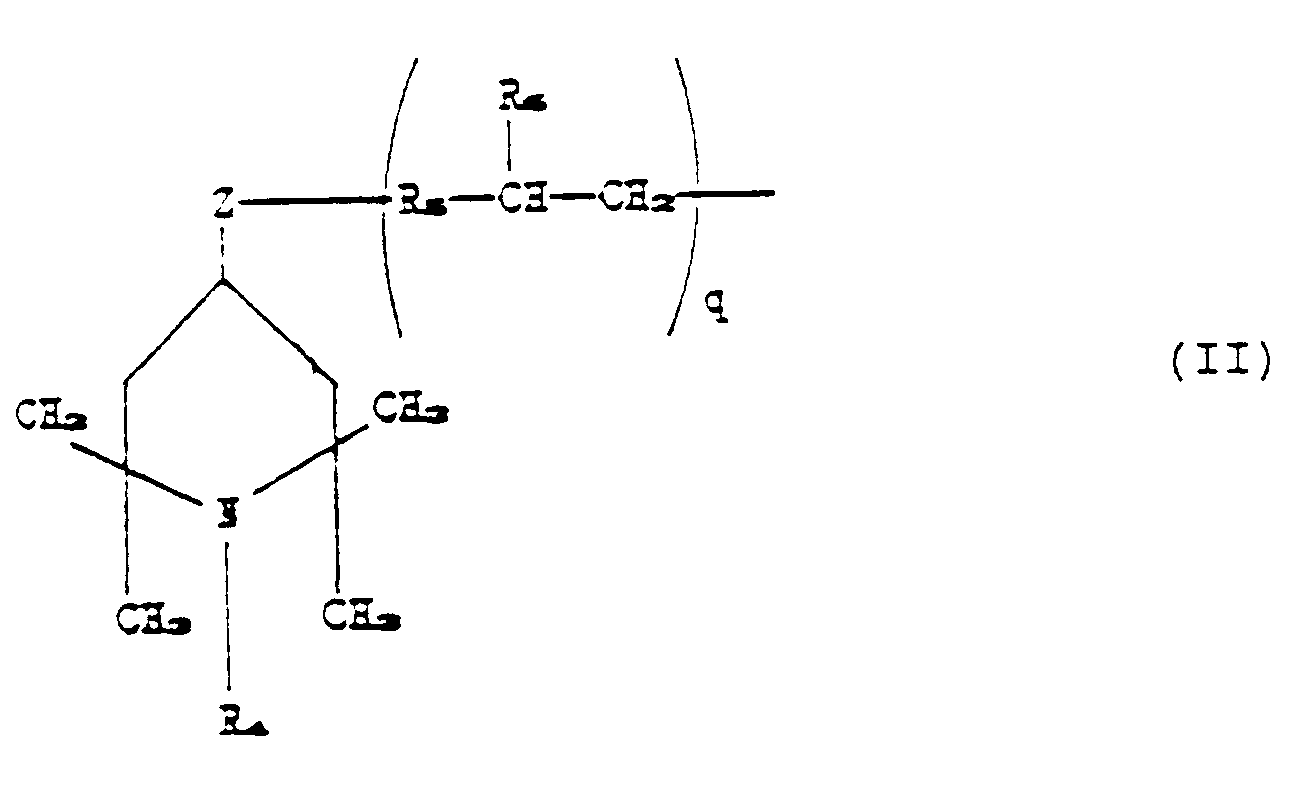
dans laquelle R₄ représente un atome d'hydrogène ou un groupe méthyle ou benzyle,
R₅ représente un groupe alkylène en C₁ à C₇, linéaire ou ramifié, R₆ représente un
atome d'hydrogène ou un groupe méthyle, Z représente un groupe -O- ou

R₇ représentant un atome d'hydrogène ou un groupe alkyle en C₁ à C₅, linéaire ou
ramifié, q représente zéro ou un, n représente un nombre entier autre que zéro, m
et p, qui peuvent être identiques ou différents, représentent zéro ou des nombres
entiers, étant entendu que la somme


est inférieure ou égale à 50,
A représente un groupe correspondant à la formule :

dans laquelle R₁ a la signification indiquée précédemment,
B représente un groupe correspondant à la formule :

dans laquelle R₁ a la signification indiquée précédemment, ou bien A et B représentent
ensemble une liaison directe, ce qui donne naissance à une structure cyclique.
2. Composés stabilisants selon la revendication 1,
caractérisés en ce que, dans la formule (I), A représente un groupe correspondant à la formule
(III), B représente un groupe correspondant à la formule (IV) et la somme

est comprise entre 10 et 50.
3. Composés stabilisants selon la revendication 2,
caractérisés en ce que, dans la formule (I), R₁ et R₃ représentent CH₃, R₂ représente le groupe
correspondant à la formule :
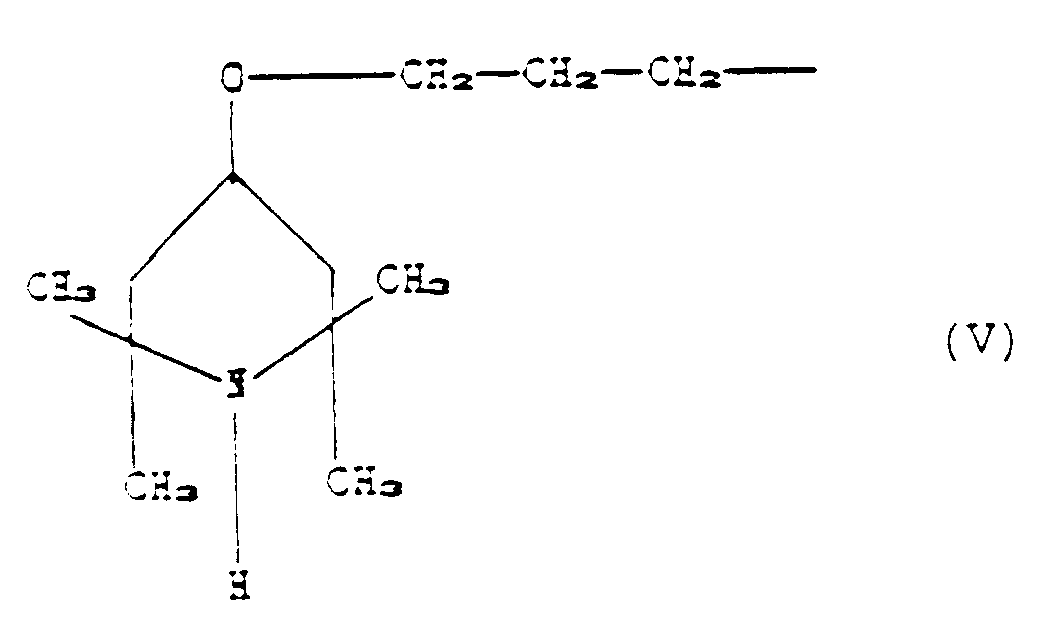
p est égal à zéro, et n et m ont une valeur allant de 5 à 15.
4. Composés stabilisants selon la revendication 2, caractérisés en ce que, dans la formule (I), R₁ représente CH₃, R₂ représente le groupe de formule
(V), n a une valeur allant de 30 à 40, et p et m sont égaux à zéro.
5. Composés stabilisants selon la revendication 2, caractérisés en ce que, dans la formule (I), R₁ représente CH₃, R₂ représente le groupe de formule
(V), R₃ représente le groupe -(CH₂)₇-CH₃, p est égal à zéro, et m et n ont une valeur
allant de 15 à 20.
6. Composés stabilisants selon la revendication 2, caractérisés en ce que, dans la formule (I), R₁ représente CH₃, R₂ représente le groupe de formule
(V), m est égal à zéro, p a une valeur allant de 5 à 12 et n a une valeur allant de
25 à 30.
7. Composés stabilisants selon la revendication 2,
caractérisés en ce que, dans la formule (I), R₁ et R₃ représentent CH₃, R₂ représente le groupe
:
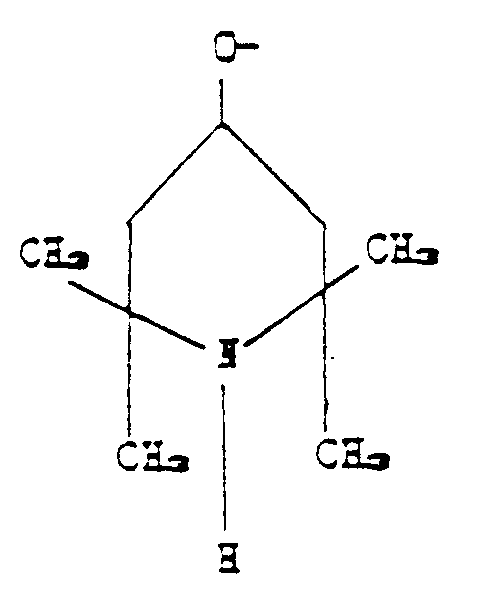
p est égal à zéro, n a une valeur allant de 20 à 25 et m a une valeur allant de 8
à 10.
8. Composés stabilisants selon la revendication 1, caractérisés en ce que, dans la formule (I), A et B représentent ensemble une liaison directe,
m et p sont égaux à zéro et n a une valeur allant de 4 à 7.
9. Composés stabilisants selon la revendication 8, caractérisés en ce que, dans la formule (I), R₁ représente CH₃ et R₂ représente le groupe de formule
(V).
10. Procédé de préparation des composés stabilisants revendiqués dans les revendications
1 à 9, pour lesquels R₂ est représenté par la formule (II) dans laquelle q est égal
à 1,
caractérisé en ce que l'on met un polyorganosiloxane correspondant à la formule :

dans laquelle A, B, R₁, R₃, n, p et m ont les significations indiquées précédemment,
en contact avec un dérivé insaturé de la pipéridine, répondant à la formule :
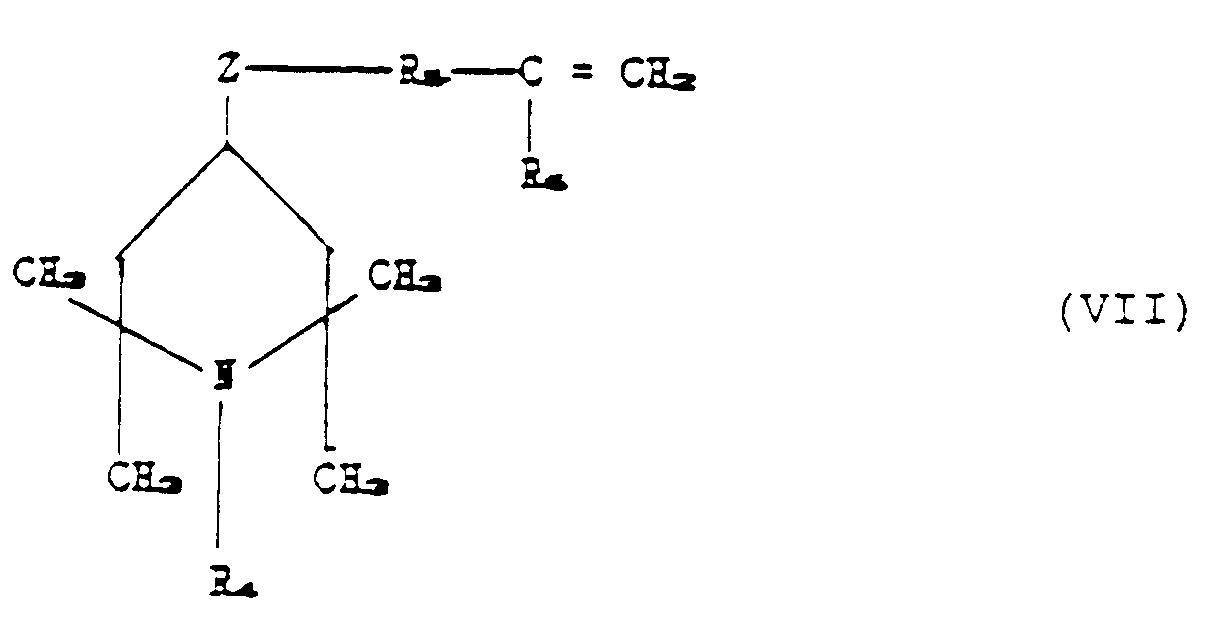
dans laquelle R₄, R₅, R₆ et Z ont les significations indiquées précédemment, dans
des conditions où il se produit une réaction, jusqu'à ce que 1 à n + p des groupes
Si-H présents dans le composé (VI) aient réagi.
11. Procédé selon la revendication 10, caractérisé en ce que l'on opère à une température comprise entre 0 et 140°C, en présence d'un
catalyseur choisi parmi les complexes de métal noble, présent à une concentration,
exprimée en métal, comprise entre 1 et 200 ppm dans le milieu réactionnel, en l'absence
de solvant ou en présence d'un solvant organique inerte, la durée de la réaction étant
comprise entre 1 heure et 10 heures.
12. Procédé selon la revendication 11, caractérisé en ce que l'on opère à une température comprise entre 80 et 120°C, en l'absence de
solvant et en présence d'un catalyseur choisi parmi les complexes du rhodium et du
platine, présent à une concentration, exprimée en métal, comprise entre 5 et 50 ppm
dans le milieu réactionnel.
13. Procédé selon la revendication 11, caractérisé en ce que le catalyseur est l'acide hexachloroplatinique ou le complexe chlorure
de rhodium-triphénylphosphine.
14. Procédé selon la revendication 11, caractérisé en ce que le solvant organique inerte est choisi parmi les hydrocarbures aliphatiques,
cycloaliphatiques ou aromatiques.
15. Procédé selon la revendication 14, caractérisé en ce que le solvant est le toluène, l'heptane ou le cyclohexane.
16. Procédé de préparation des composés stabilisants revendiqués dans les revendications
1 à 9, pour lesquels R₂ est représenté par la formule (II) dans laquelle q est égal
à zéro,
caractérisé en ce que l'on met un polyorganosiloxane répondant à la formule (VI) précédente en
contact avec un dérivé de la pipéridine, répondant à la formule :
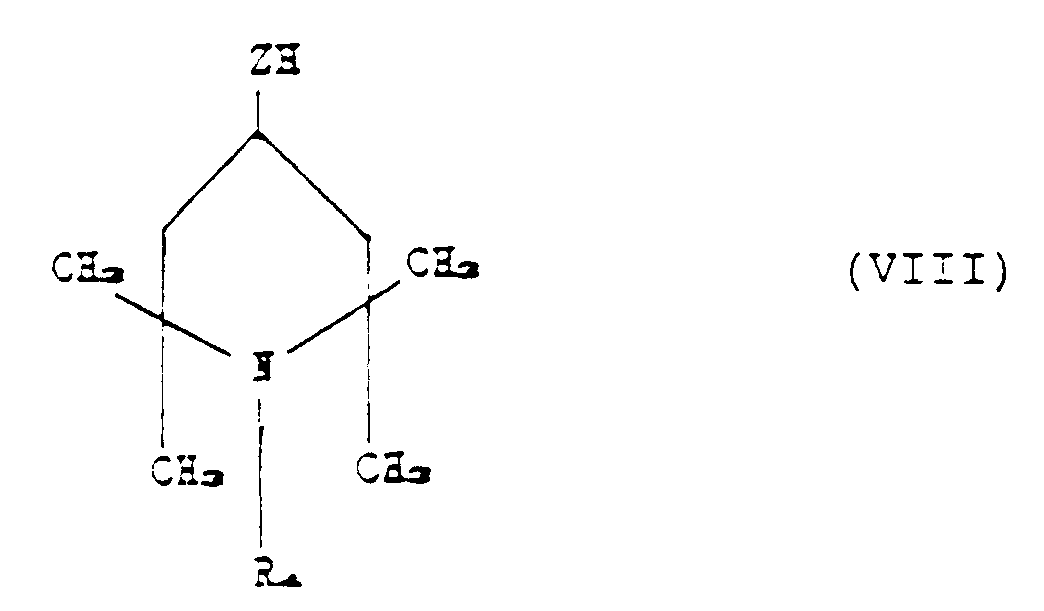
dans laquelle Z et R₄ ont les significations indiquées précédemment, dans des conditions
où se produit une réaction, jusqu'à ce que 1 à n + p des groupes Si-H présents dans
le composé (VI) aient réagi.
17. Procédé selon la revendication 16, caractérisé en ce que l'on opère à une température comprise entre 20 et 150°C, en présence d'un
catalyseur choisi parmi les alcoolates métalliques et les sels métalliques d'acides
gras, présents en une proportion comprise entre 0,01 % et 5 % en moles par rapport
au composé (VIII), et en présence d'un solvant organique inerte, choisi parmi les
hydrocarbures aliphatiques ou cycloaliphatiques, la durée de la réaction étant comprise
entre 1 heure et 10 heures.
18. Procédé selon la revendication 17, caractérisé en ce que l'on opère à une température comprise entre 60 et 120°C, en utilisant une
proportion de catalyseur comprise entre 0,1 % et 1 % en moles par rapport au composé
(VIII).
19. Procédé selon la revendication 17, caractérisé en ce que le catalyseur est choisi parmi le méthylate de sodium, l'octoate de zinc
et l'octoate d'étain.
20. Procédé selon la revendication 17, caractérisé en ce que le solvant est le cyclohexane, l'heptane ou le toluène.
21. Procédé de préparation des composés stabilisants revendiqués dans les revendications
1 à 9, pour lesquels R₂ est représenté par la formule (II) dans laquelle Z représente
-O- et q est égal à un,
caractérisé en ce qu'il comprend les étapes suivantes, réalisées successivement :
a) la réaction d'un polyorganosiloxane représenté par la formule (VI) précédente avec
un composé insaturé correspondant à la formule :

dans laquelle R₅ et R₆ ont les significations indiquées précédemment et X représente
un atome de chlore ou de brome, de façon à obtenir un polyorganosiloxane correspondant
à la formule suivante :
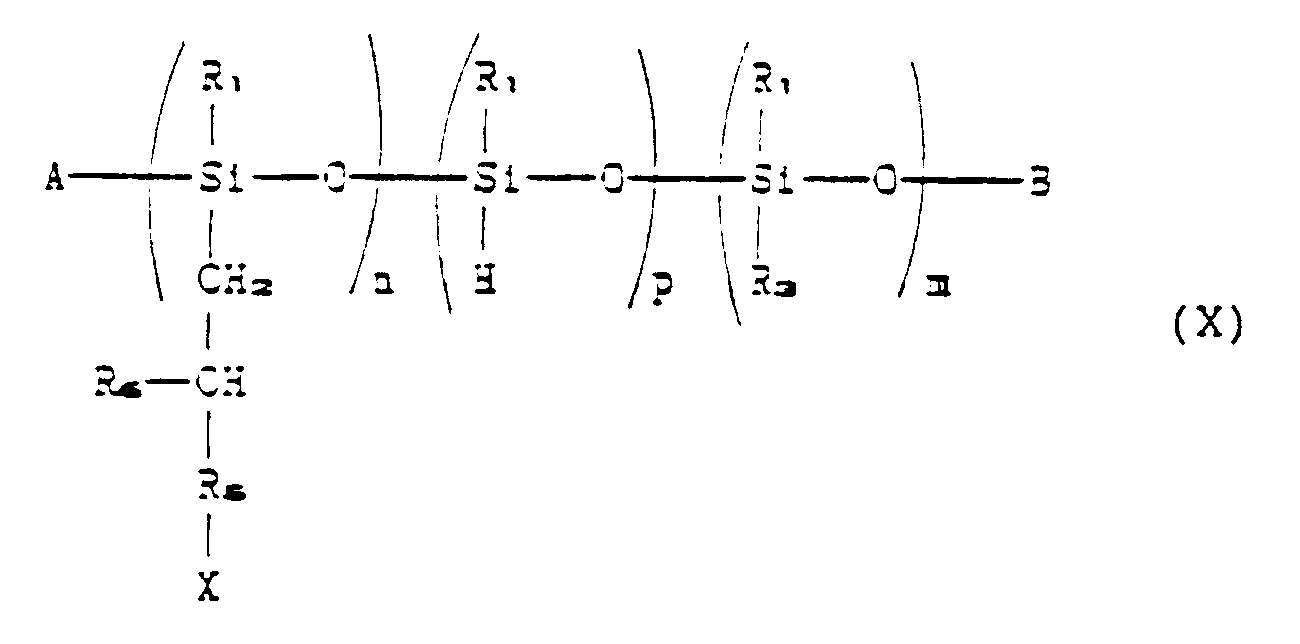
dans laquelle R₁, R₃, R₅, R₆, A, B, X, n, p et m ont les significations indiquées
précédemment,
b) la réaction du composé (X) obtenu dans l'étape a), avec un dérivé de pipéridine,
correspondant à la formule :
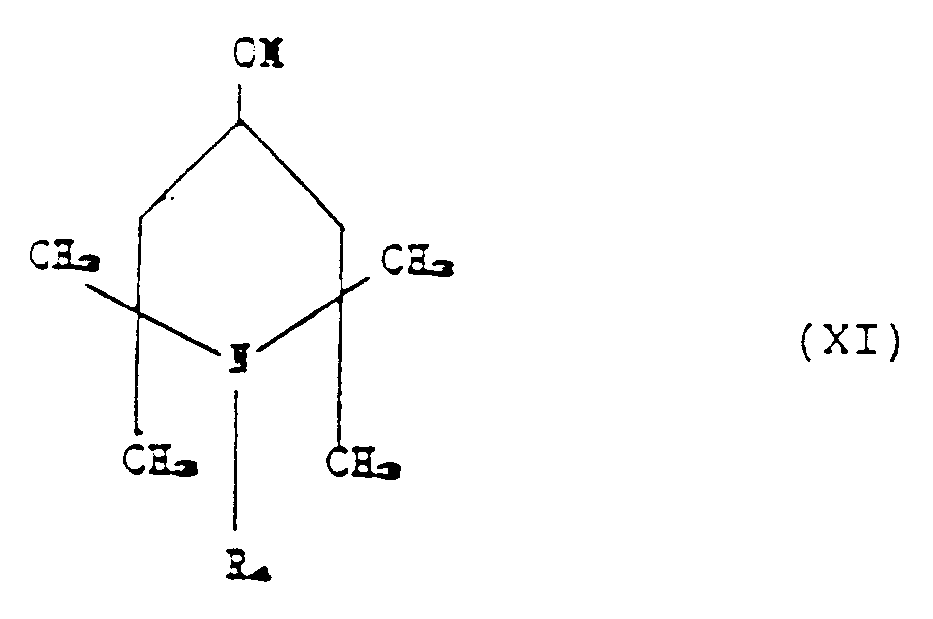
dans laquelle R₄ a la signification indiquée précédemment, et M représente Na, K
ou Li.
22. Procédé selon la revendication 21, caractérisé en ce que, dans l'étape a), on opère à une température comprise entre 80 et 120°C,
pendant une durée comprise entre 1 et 10 heures, en présence d'un solvant organique
inerte, choisi parmi les hydrocarbures aliphatiques, cycloaliphatiques ou aromatiques,
en utilisant, comme catalyseur, un complexe de métal noble, présent à une concentration,
exprimée en métal, comprise entre 1 et 200 ppm dans le milieu réactionnel.
23. Procédé selon la revendication 22, caractérisé en ce que, dans l'étape a),on opère à une température comprise entre 80 et 120°C,
en utilisant, comme catalyseur, un complexe du platine ou du rhodium, présent à une
concentration comprise entre 5 et 50 ppm dans le milieu réactionnel.
24. Procédé selon la revendication 22, caractérisé en ce que le catalyseur est l'acide hexachloroplatinique ou le complexe chlorure
de rhodium-triphénylphosphine.
25. Procédé selon la revendication 22, caractérisé en ce que le solvant inerte est le toluène, l'heptane ou le cyclohexane.
26. Procédé selon la revendication 21, caractérisé en ce que, dans l'étape b), on opère à une température comprise entre 25 et 80°C,
pendant une durée comprise entre 4 et 10 heures, en présence d'un solvant organique
inerte choisi parmi les hydrocarbures aliphatiques, cycloaliphatiques ou aromatiques,
en utilisant une quantité stoechiométrique de composé (XI) par rapport au composé
(IX).
27. Compositions stabilisées de polymère, caractérisées en ce qu'elles comprennent un polymère organique, choisi parmi les homopolymères
d'oléfines et de dioléfine, les copolymères d'oléfine et de monomères vinyliques,
le polystyrène, les copolymères et terpolymères de styrène avec des diènes ou avec
des monomères acryliques, et les polyuréthanes, et une quantité de composé stabilisant
revendiqué dans les revendications 1 à 9, qui fournit de 0,0005 % à 0,27 % en poids
d'azote actif.
28. Compositions stabilisées de polymère selon la revendication 27, caractérisées en ce qu'elles comprennent un polymère organique et une quantité de composé stabilisant
revendiqué dans les revendications 1 à 5, qui fournit de 0,003 % à 0,054 % en poids
d'azote actif.
29. Compositions stabilisées de polymère selon la revendication 27 ou 28, caractérisées en ce qu'elles contiennent en plus d'autres agents de stabilisation vis-à-vis des
UV et/ou d'autres additifs habituellement utilisés dans la technique, en une proportion
comprise entre 0,01 % et 5 % en poids par rapport au polymère organique.
30. Compositions stabilisées de polymère selon les revendications 27 à 29, caractérisées en ce que le composé stabilisant est fixé à un support solide contenant des groupes
hydroxyle en surface.
31. Compositions stabilisées de polymère selon la revendication 30, caractérisées en ce que le support solide est un matériau siliceux, naturel ou synthétique, ou
TiO₂.
32. Compositions stabilisées de polymère selon la revendication 31, caractérisées en ce que le support solide est des fibres de verre, du gel de silice, du talc, du
kaolin, du mica, de la célite, de la terre de diatomées ou du TiO₂.
33. Compositions stabilisées de polymère selon la revendication 27, caractérisées en ce que le polymère organique est du polypropylène, du polyéthylène de basse densité
ou de densité élevée, du polyéthylène linéaire de basse densité, du polybutadiène
ou du polyuréthane.
Revendications pour l'(les) Etat(s) contractant(s) suivant(s): ES
1. Procédé de préparation de composés stabilisants polymères, répondant à la formule
générale :

dans laquelle R₁ et R₃, qui peuvent être identiques ou différents, représentent des
groupes alkyle en C₁ à C₁₀, linéaires ou ramifiés, des groupes cycloaliphatiques en
C₅ à C₁₁ ou des groupes phényle,
R₂ représente un groupe choisi parmi ceux correspondant à la formule suivante :

dans laquelle R₄ représente un atome d'hydrogène ou un groupe méthyle ou benzyle,
R₅ représente un groupe alkylène en C₁ à C₇, linéaire ou ramifié, R₆ représente un
atome d'hydrogène ou un groupe méthyle, Z représente un groupe -O- ou
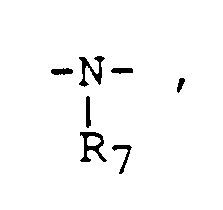
R₇ représentant un atome d'hydrogène ou un groupe alkyle en C₁ à C₅, linéaire ou
ramifié, q représente zéro ou un, n représente un nombre entier autre que zéro, m
et p, qui peuvent être identiques ou différents, représentent zéro ou des nombres
entiers, étant entendu que la somme


est inférieure ou égale à 50,
A représente un groupe correspondant à la formule :

dans laquelle R₁ a la signification indiquée précédemment,
B représente un groupe correspondant à la formule :

dans laquelle R₁ a la signification indiquée précédemment,
ou bien A et B représentent ensemble une liaison directe, ce qui donne naissance
à une structure cyclique,
caractérisé en ce que l'on met un polyorganosiloxane correspondant à la formule :

dans laquelle A, B, R₁, R₃, n, p et m ont les significations indiquées précédemment,
en contact, dans des conditions conduisant à une réaction, avec :
a) un dérivé insaturé de pipéridine, correspondant à la formule :

dans laquelle R₄, R₅, R₆ et Z ont les significations indiquées précédemment, lorsque
R₂ est représenté par la formule (II) dans laquelle q est égal à un,
ou
b) un dérivé de pipéridine, correspondant à la formule :

dans laquelle Z et R₄ ont les significations indiquées précédemment, lorsque R₂ est
représenté par la formule (II) dans laquelle q est égal à zéro,
jusqu'à ce que 1 à n + p des groupes Si-H présents dans le composé (VI) aient réagi.
2. Procédé selon la revendication 1,
caractérisé en ce que, dans la formule (I), A représente un groupe correspondant à la formule
(III), B représente un groupe correspondant à la formule (IV) et la somme


est comprise entre 10 et 50.
3. Procédé selon la revendication 2,
caractérisé en ce que, dans la formule (I), R₁ et R₃ représentent CH₃, R₂ représente le groupe
correspondant à la formule :

p est égal à zéro, et n et m ont une valeur allant de 5 à 15.
4. Procédé selon la revendication 2, caractérisé en ce que, dans la formule (I), R₁ représente CH₃, R₂ représente le groupe de formule
(V), n a une valeur allant de 30 à 40, et p et m sont égaux à zéro.
5. Procédé selon la revendication 2, caractérisé en ce que, dans la formule (I), R₁ représente CH₃, R₂ représente le groupe de formule
(V), R₃ représente le groupe -(CH₂)₇-CH₃, p est égal à zéro, et m et n ont une valeur
allant de 15 à 20.
6. Procédé selon la revendication 2, caractérisé en ce que, dans la formule (I), R₁ représente CH₃, R₂ représente le groupe de formule
(V), m est égal à zéro, p a une valeur allant de 5 à 12 et n a une valeur allant de
25 à 30.
7. Procédé selon la revendication 2,
caractérisé en ce que, dans la formule (I), R₁ et R₃ représentent CH₃, R₂ représente le groupe
:
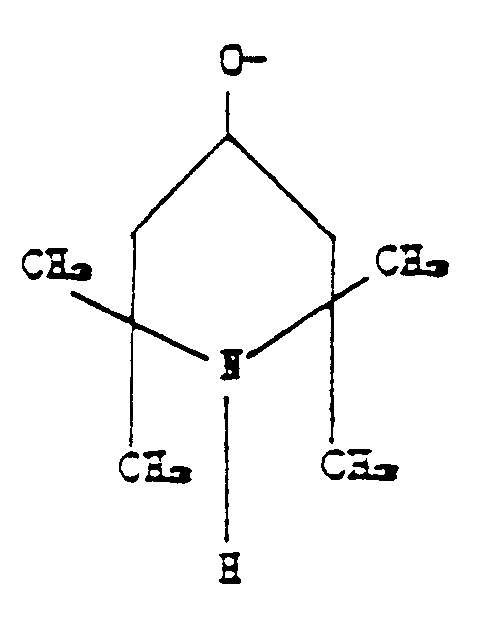
p est égal à zéro, n a une valeur allant de 20 à 25 et m a une valeur allant de 8
à 10.
8. Procédé selon la revendication 1, caractérisé en ce que, dans la formule (I), A et B représentent ensemble une liaison directe,
m et p sont égaux à zéro et n a une valeur allant de 4 à 7.
9. Procédé selon la revendication 8, caractérisé en ce que, dans la formule (I), R₁ représente CH₃ et R₂ représente le groupe de formule
(V).
10. Procédé selon la revendication 1, pour la préparation des composés pour lesquels q
est égal à 1, caractérisé en ce que l'on opère à une température comprise entre 0 et 140°C, en présence d'un
catalyseur choisi parmi les complexes de métal noble, présent à une concentration,
exprimée en métal, comprise entre 1 et 200 ppm dans le milieu réactionnel, en l'absence
de solvant ou en présence d'un solvant organique inerte, la durée de la réaction étant
comprise entre 1 heure et 10 heures.
11. Procédé selon la revendication 10, caractérisé en ce que l'on opère à une température comprise entre 80 et 120°C, en l'absence de
solvant et en présence d'un catalyseur choisi parmi les complexes du rhodium ou du
platine, présent à une concentration, exprimée en métal, comprise entre 5 et 50 ppm
dans le milieu réactionnel.
12. Procédé selon la revendication 10, caractérisé en ce que le catalyseur est l'acide hexachloroplatinique ou le complexe chlorure
de rhodium-triphénylphosphine.
13. Procédé selon la revendication 10, caractérisé en ce que le solvant organique inerte est choisi parmi les hydrocarbures aliphatiques,
cycloaliphatiques ou aromatiques.
14. Procédé selon la revendication 13, caractérisé en ce que le solvant est le toluène, l'heptane ou le cyclohexane.
15. Procédé selon la revendication 1, pour la préparation des composés pour lesquels q
est égal à zéro, caractérisé en ce que l'on opère à une température comprise entre 20 et 150°C, en présence d'un
catalyseur choisi parmi les alcoolates métalliques et les sels métalliques d'acides
gras, présents en une proportion comprise entre 0,01 % et 5 % en moles par rapport
au composé (VIII), et en présence d'un solvant organique inerte, choisi parmi les
hydrocarbures aliphatiques ou cycloaliphatiques, pendant une durée comprise entre
1 heure et 10 heures.
16. Procédé selon la revendication 15, caractérisé en ce que l'on opère à une température comprise entre 60 et 120°C, en utilisant une
proportion de catalyseur comprise entre 0,1 % et 1 % en moles par rapport au composé
(VIII).
17. Procédé selon la revendication 15, caractérisé en ce que le catalyseur est choisi parmi le méthylate de sodium, l'octoate de zinc
et l'octoate d'étain.
18. Procédé selon la revendication 15, caractérisé en ce que le solvant est le cyclohexane, l'heptane ou le toluène.
19. Procédé de préparation de compositions stabilisées de polymère, caractérisé en ce qu'il comprend l'étape consistant à combiner ensemble un polymère organique,
choisi parmi les homopolymères d'oléfine et de dioléfine, les copolymères d'oléfines
et de monomères vinyliques, le polystyrène, les copolymères et terpolymères de styrène
avec des diènes ou avec des monomères acryliques, et les polyuréthanes, et une quantité
de composé stabilisant préparé par le procédé selon les revendications 1 à 9, qui
fournit de 0,0005 % à 0,27 % en poids d'azote actif.
20. Procédé de préparation de compositions stabilisées de polymère selon la revendication
19, caractérisé en ce qu'il comprend l'étape consistant à combiner ensemble un polymère organique
et une quantité de composé stabilisant préparé par le procédé selon les revendications
1 à 5, qui fournit de 0,003 % à 0,054 % en poids d'azote actif.
21. Procédé selon la revendication 19 ou 20, caractérisé en ce qu'il comprend en outre l'addition d'autres agents de stabilisation vis-à-vis
des UV et/ou d'autres additifs habituellement utilisés dans la technique, en une proportion
comprise entre 0,01 % et 5 % en poids par rapport au polymère organique.
22. Procédé selon les revendications 19 à 21, caractérisé en ce que le composé stabilisant est fixé à un support solide, contenant des groupes
hydroxyle en surface.
23. Procédé selon la revendication 22, caractérisé en ce que le support solide est un matériau siliceux, naturel ou synthétique, ou
du TiO₂.
24. Procédé selon la revendication 23, caractérisé en ce que le support solide est des fibres de verre, du gel de silice, du talc, du
kaolin, du mica, de la célite, de la terre de diatomées ou du TiO₂.
25. Procédé selon la revendication 19, caractérisé en ce que le polymère organique est du polypropylène, du polyéthylène basse densité
ou du polyéthylène de densité élevée, du polyéthylène linéaire basse densité, du polybutadiène
ou du polyuréthane.
